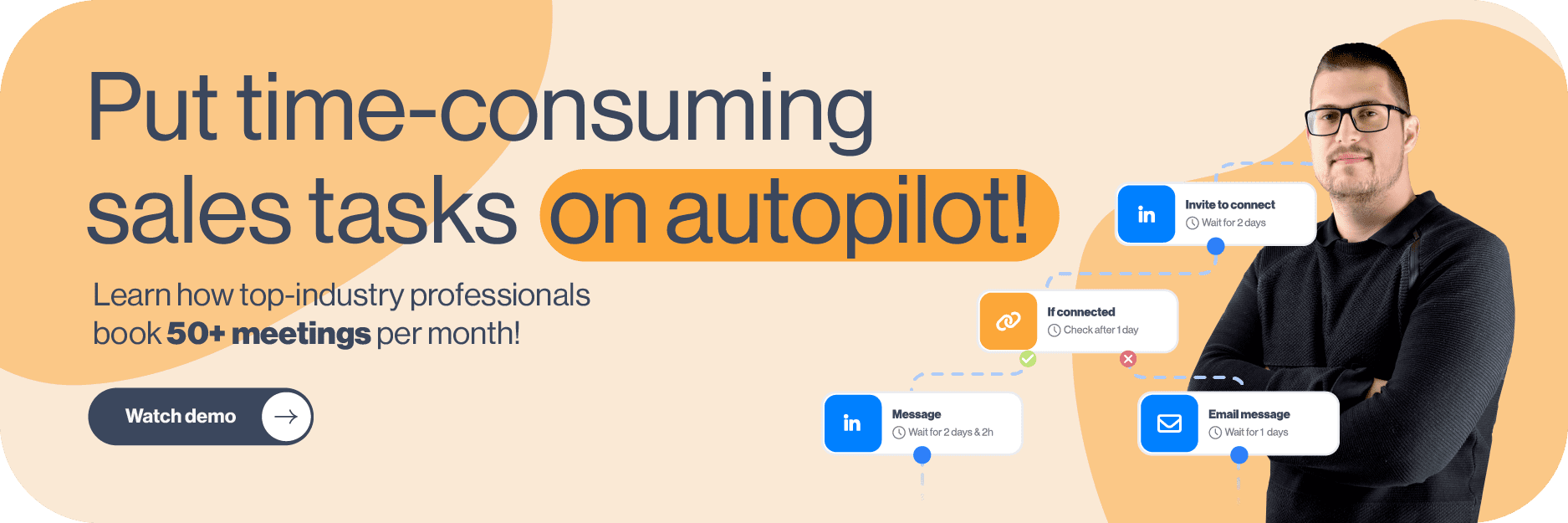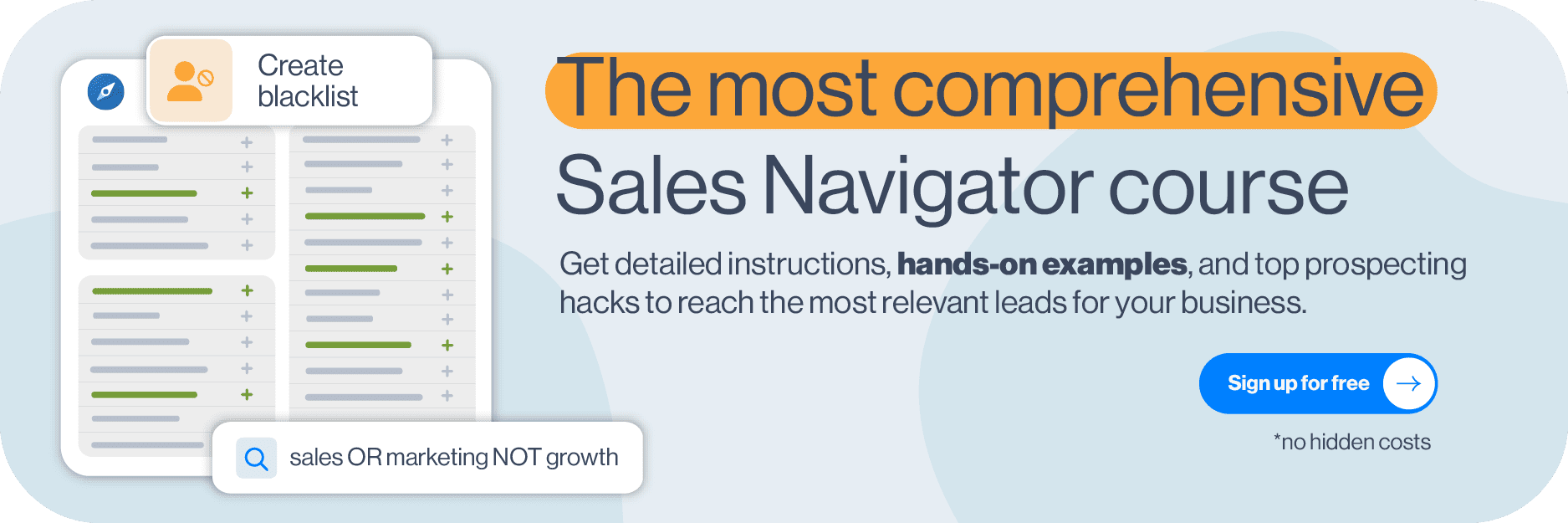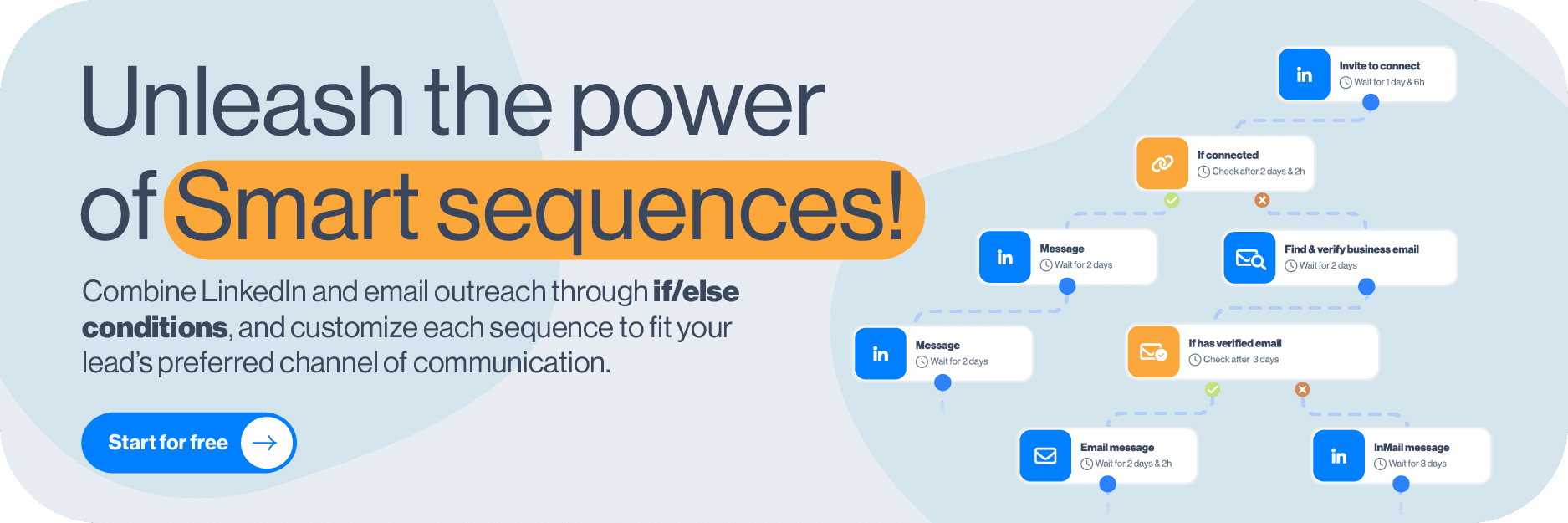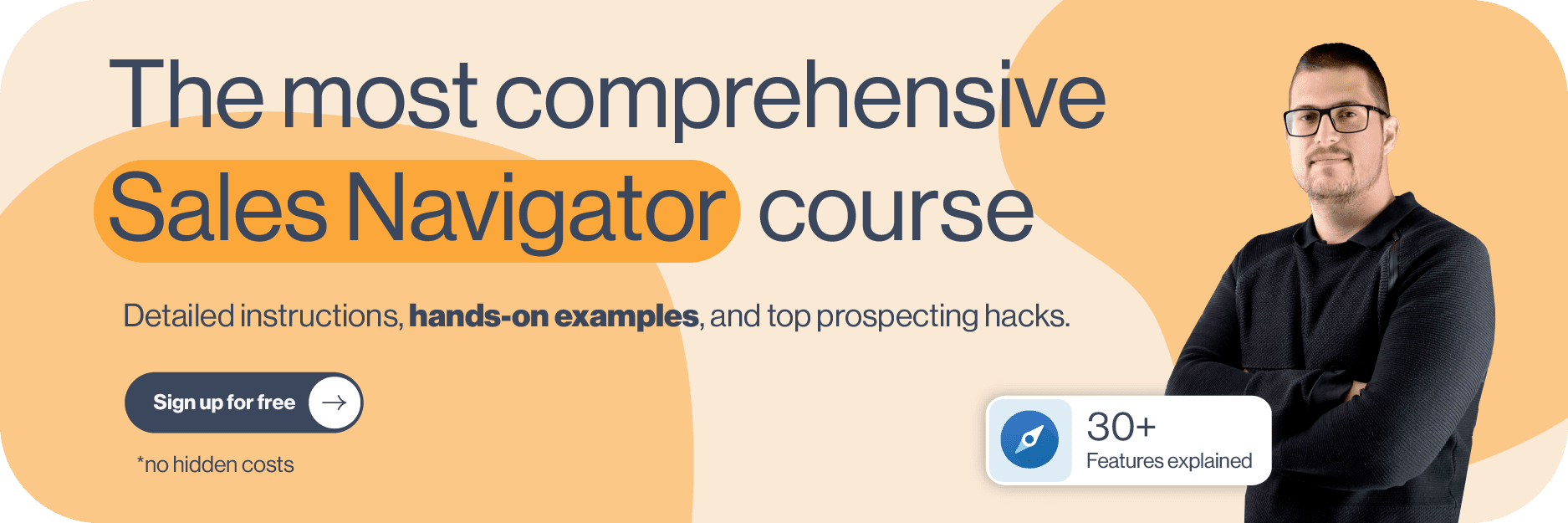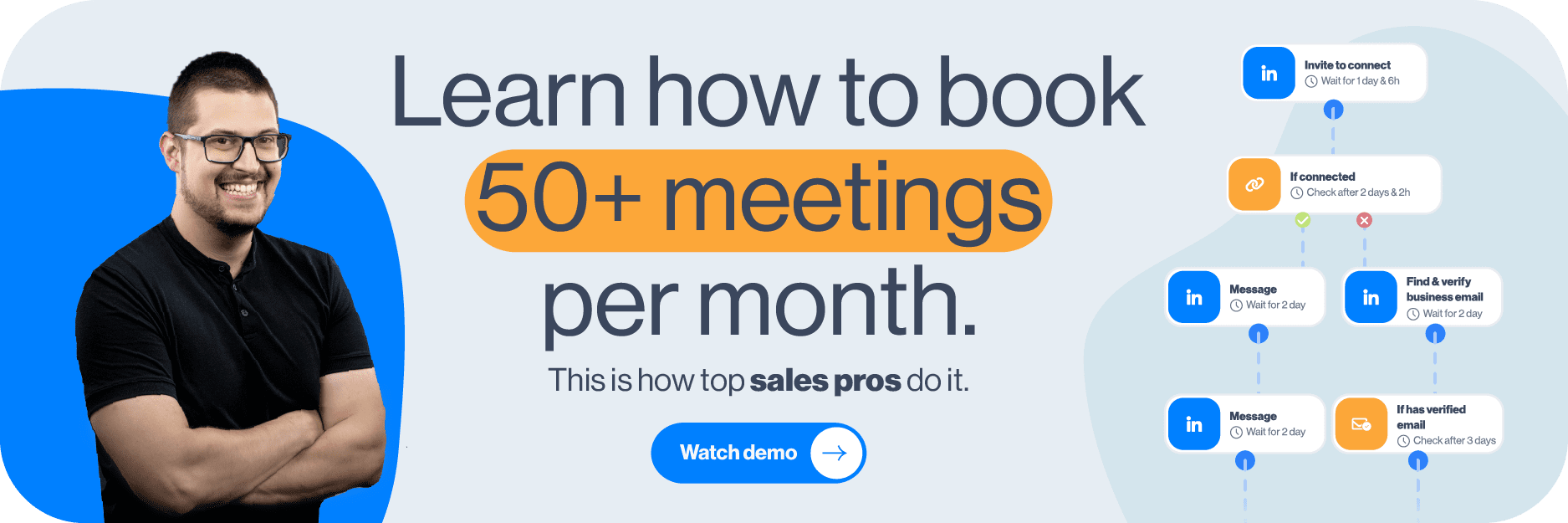Lead acquisition is the process of obtaining potential clients or leads and guiding them through the sales funnel toward conversion. Additionally, it involves capturing, filtering, and nurturing leads until they are ready to make a purchase.
For businesses, lead acquisition is decisive as it forms the foundation of their customer acquisition strategy. With a steady stream of qualified leads, companies can sustain growth and profitability.
That’s why, to keep their lead acquisition process afloat, businesses primarily utilize lead generation systems. To clarify, a lead generation system is a comprehensive software designed to help you gather, attract, speak with and convert leads into paying customers.
Now let’s dive into what lead acquisition is and how it differs from lead generation, and why they are inseparable. Also, we will show you some highly effective tactics that you can use to get more clients in the future.
What is a lead?
A lead is an individual or organization demonstrating an interest in purchasing the products or services offered by a business. In other words, it represents a potential customer who has engaged with the company. This could involve filling out a form or subscribing to a newsletter.
What is lead acquisition?
Lead acquisition is the process of obtaining potential customers and guiding them toward becoming qualified leads. It involves capturing, filtering, and integrating leads into the lead acquisition funnel for further nurturing and conversion.
Lead acquisition may include activities such as,
- Lead generation through marketing campaigns and other inbound strategies to attract potential customers,
- Networking or building relationships within relevant industries and communities,
- Or engaging with prospects through outbound strategies such as multichannel outreach.
The primary goal of lead acquisition is to build a pool of qualified leads and convert them.
1. Lead generation
This is about attracting possible customers, getting their contact details and reaching out to them. For example, you can do this by sharing content, reaching out on social media, and making your website visible to search engines manually.
However, you can also automate part of your lead generation process.
Automated lead generation involves using software tools and processes to gather, attract, and engage potential leads without manual intervention. In other words, these tools streamline the outreach process in lead generation, enabling businesses to reach a larger audience more efficiently.
Skylead is one such tool that facilitates automated outreach in lead generation, particularly using LinkedIn and email. To clarify, Skylead is a LinkedIn automation and cold email software designed to streamline and optimize outreach efforts for businesses. It offers features such as:
| Feature | Description |
| LinkedIn Automation | Skylead automates personalized connection requests, messages, and paid/free InMails on LinkedIn, enhancing outreach to potential leads. |
| Multichannel Outreach | It also enables users to combine LinkedIn automation with email automation, maximizing touchpoints with leads and enhancing engagement possibilities. |
| Smart Sequences | Skylead offers Smart sequence capabilities for building personalized multichannel flows with if/else conditions, ensuring effective lead acquisition. |
| Email Discovery & Verification | It provides a native feature for discovering and double verifying email addresses of potential leads, ensuring accurate contact information for successful outreach efforts. |
| Image & GIF Personalization | Skylead allows users to personalize outreach with images and GIFs, enhancing response rate and memorability for potential leads. |
But more on this later. 😊
2. Market dominance
Apart from getting leads, you should also become a top player in your field. In other words, this means being known as a reliable source of information and solutions in your industry. It also involves establishing trust in your field. You can do this by consistently offering valuable content and engaging with your leads.
You can easily do this by using simple lead acquisition marketing tactics.
Again, you either do it manually (that will take a lot of time) or automate the entire process using smart tools like Skylead.
With Skylead, you can effortlessly establish yourself as a thought leader in your industry by automating the expansion of your LinkedIn network. Here’s how 👇
| Action | Description |
| Become a Thought Leader | Expand your LinkedIn network on autopilot to establish yourself as an industry authority. |
| Share Content Campaigns | Use campaigns to distribute posts on LinkedIn and other content to your network. Thus, ensuring engagement even if they missed your posts. |
| Promote Events with Smart Sequences | Utilize Smart Sequences to promote events and connect with attendees through LinkedIn and email. |
| Manage Conversations in Skylead's Smart Inbox | Streamline LinkedIn conversations by managing them all within Skylead's Smart Inbox feature. |
| Re-engage Network with View & Follow Steps | Incorporate View & Follow steps in sequences to maintain engagement and re-engage your network. |
3. Lead qualification, nurturing and conversion
In this step, firstly, figure out which leads are most likely to buy from you. For example, look at things like how interested they are, their budget, and how much say they have in their organization. By scoring and dividing leads, you can focus your efforts on the ones most likely to become customers.
Once you start talking to your leads, personalize your messaging and address their pain points precisely to successfully nurture them. Lastly, prepare your objection handling rebuttals to ensure lead conversion.
What are lead acquisition models?
Businesses deploy various lead acquisition models to optimize their customer acquisition process. Some of them are as follows:
- Firstly, Inbound marketing and sales attracts leads through valuable content, SEO, and social media engagement. This model focuses on drawing prospects to the business naturally for sales.
- Secondly, outbound marketing and sales means reaching out to possible customers by calling, emailing, or advertising to them directly. It's a proactive way for businesses to connect with potential buyers for selling purposes.
- Thirdly, the referral-based lead acquisition model relies on leveraging existing customer networks to generate new leads. Businesses can tap into a network of pre-qualified leads by incentivizing current customers to refer others.
- Fourthly, the strategic partnerships model allows businesses to collaborate with complementary companies to access each other's customer bases. This model leverages shared audiences to expand reach and acquire new leads.
- Lastly, the event-based lead acquisition model involves participating in industry events, conferences, and trade shows to connect with potential leads face-to-face. These events provide opportunities for direct interaction and relationship-building with prospects.
Lead generation Vs. Lead acquisition - Difference between lead generation and lead acquisition
In the customer acquisition process, people often interchangeably use lead acquisition and lead generation, but they represent distinct phases.
Lead generation involves collecting contact information from potential customers interested in a product or service. Additionally, depending on the organization, lead generation may be handled by either the marketing or sales department. Here’s how they differ:
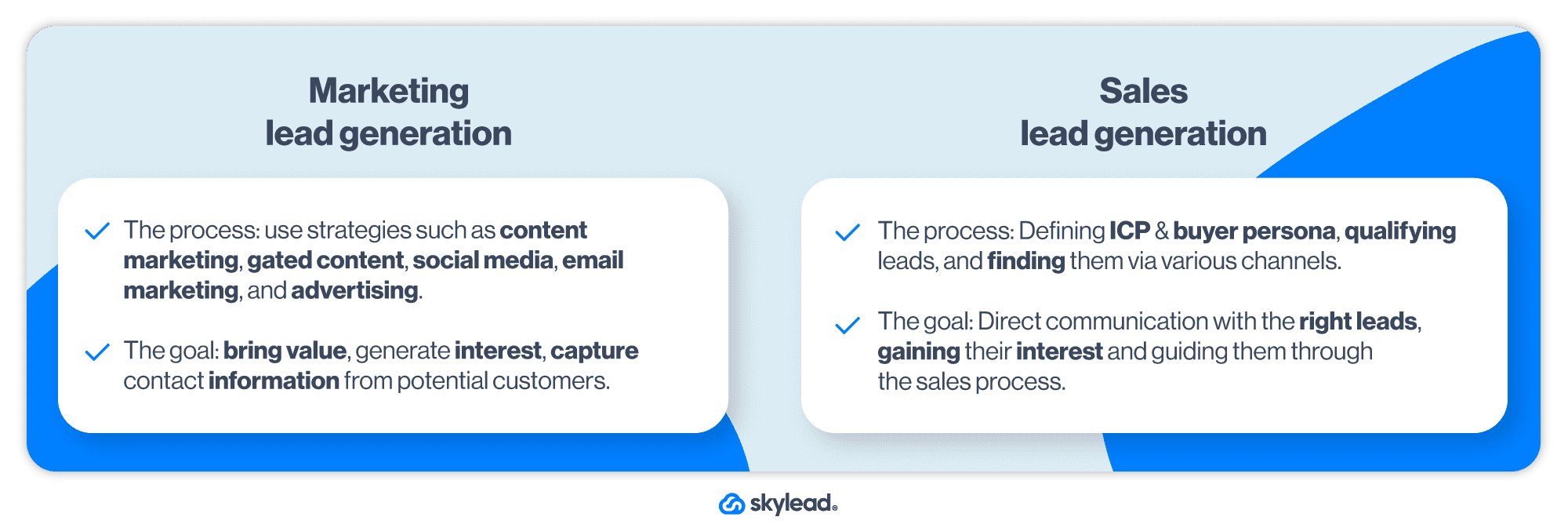
On the other hand, lead acquisition involves filtering and nurturing these leads to convert them into qualified prospects.
The primary difference (between lead generation and acquisition) lies in the timing and scope of engagement with potential customers.
Lead generation focuses on initiating contact and capturing interest, while lead acquisition goes one step further. It encompasses a broader set of activities aimed at qualifying and nurturing leads until they are ready for conversion.
Essentially, lead generation is about generating raw leads, while lead acquisition involves refining these leads for the sales process.
Here’s a summary of the main differences between the two terms.
| Aspect | Lead Generation | Lead Acquisition |
| Definition | Lead generation involves capturing potential customers' interest. | Lead acquisition encompasses gaining, filtering, and incorporating leads into systems. |
| Focus | Emphasizes attracting leads through marketing and sales efforts. | Focuses on obtaining, filtering, and preparing leads for conversion. |
| Process | Involves activities like, Marketing > content, SEO, and PPC. Sales > prospecting, initial contact, qualification and booking a meeting. | Includes lead nurturing, segmentation and closing. |
| Ownership | Businesses generate leads internally or through campaigns. | Leads can be acquired internally or through various channels and partnerships. |
| Timing | Happens before the lead enters the sales funnel. | Occurs after lead generation, preparing leads for conversion. |
Best lead acquisition strategies for improved ROI & conversion
Maximizing ROI through lead acquisition strategies involves a mix of tactics customized to your target audience and industry. Here are a few methods you can consider.
1. Quality over quantity
Prioritize quality over quantity when it comes to lead acquisition.
Focusing solely on generating a high volume of leads may be tempting. But, as we previously mentioned, it is important to ensure that these leads will be genuinely interested.
Invest time and resources in targeting prospects who align closely with your ideal customer profile (ICP) and buyer persona. By focusing on quality, you can increase the likelihood of securing valuable conversions and improve your return on investment (ROI).
Trust us—from our experience, a smaller number of high-quality leads can yield better results than a large volume of unqualified leads. Moreover, a large volume of leads can exhaust your time and resources with significantly worse results.
2. Qualify your leads
The more you qualify your leads, the better results you will get. So, to sort out leads for proper lead qualification, determine the following:
- Your business’s ICP (Ideal Customer Profile).
- Buyer Persona.
Your ICP (Ideal Customer Profile) outlines the characteristics of your ideal company, such as industry, company size, and specific pain points your product or service addresses.
Similarly, creating buyer personas helps you understand your potential customers better by identifying their needs, challenges, goals, and purchasing behaviors.
After you have established your ICP and buyer personas, you'll determine which leads are most likely to buy from you.
You can take into account factors such as,
- your lead’s level of interest,
- their budget,
- and their decision-making power within their organization (i.e., their status within the company).
By scoring and categorizing leads, you can focus your efforts on those most likely to convert into customers.
Once you have a clear understanding of your leads, nurture them by providing personalized content and valuable resources. Personalize your communication to address their specific needs and interests, guiding them through the sales funnel.
3. Check for intent
Some platforms, such as LinkedIn Sales Navigator or G2 offer information about Buyer Intent. This allows sales professionals to identify and prioritize potential leads based on their level of interest in your business.
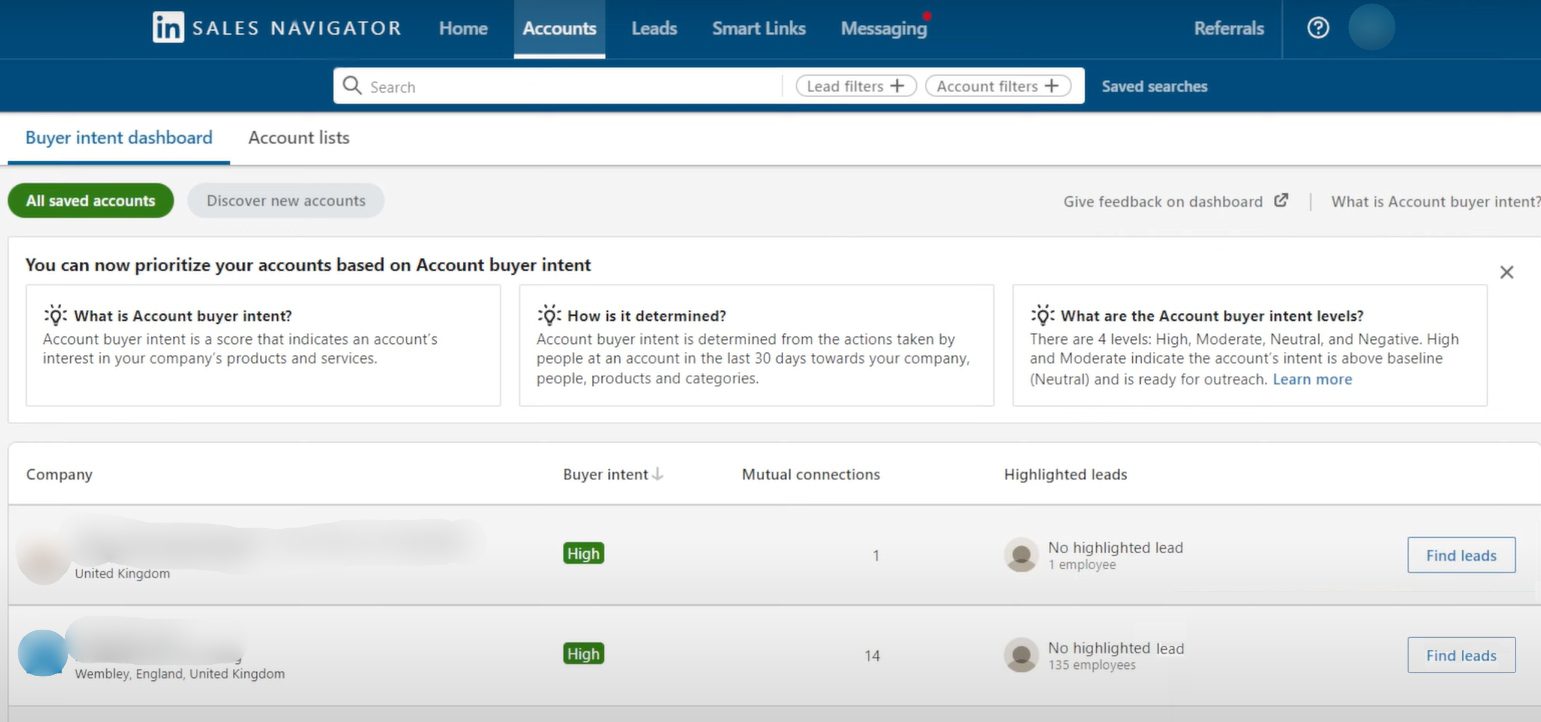
That said, if you have the budget, you should check out these platforms and test their power. We know we have. 🙂
4. Monitor entire customer journeys and use attribution
To improve ROI, it's important to monitor entire customer journeys and utilize attribution effectively. Attribution lets you connect marketing efforts and channels with actual purchases. This can give you ideas on how to get more customers in a smarter way.
Here's how you can monitor everything, depending on whether you belong to sales or marketing departments.
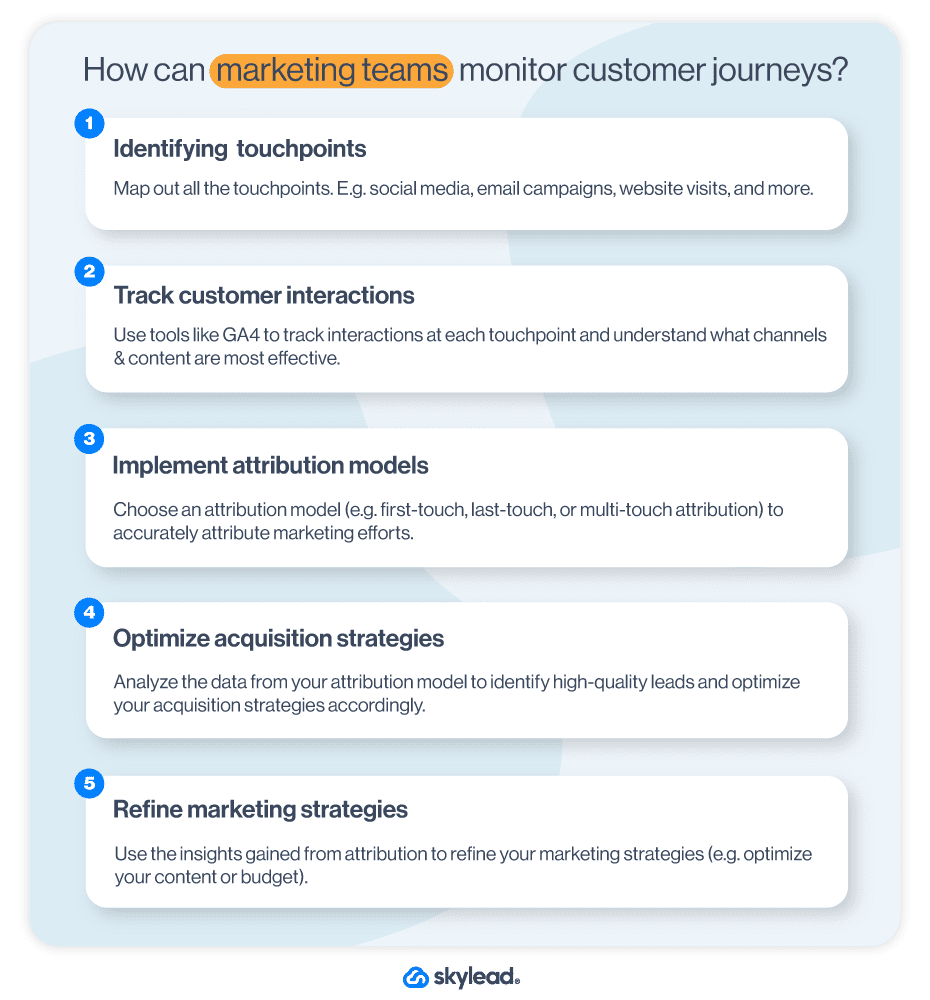
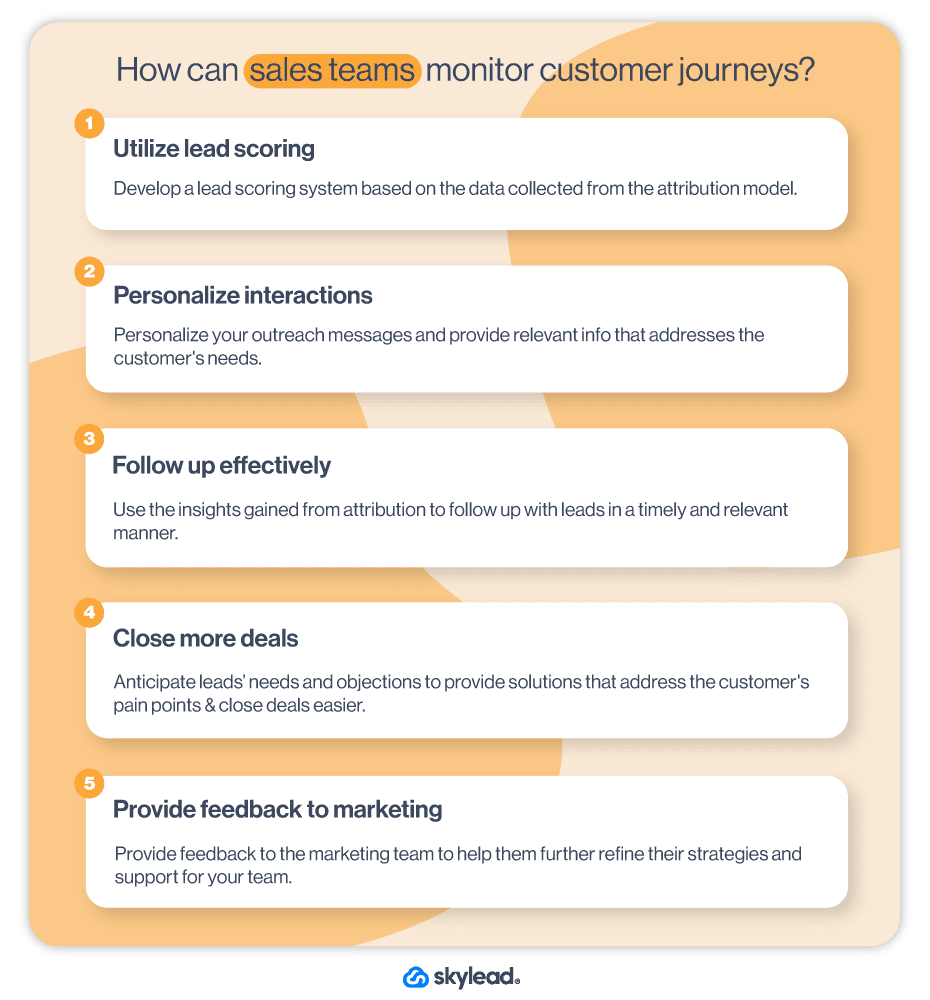
5. Lead segmentation
Segmentation is key to enhancing lead acquisition effectiveness. Sorting your leads based on various criteria such as demographics, acquisition channels, and behavioral traits. This helps you treat each group differently for better results.
For instance, leads from different channels may have varying levels of interest or engagement, requiring different nurturing strategies. Sorting leads helps you focus on the ones most likely to buy from you.
Segmentation also lets you give people content that suits them best, making them more likely to buy from you.
6. Do proactive lead acquisition for marketing and sales during the acquisition process
Businesses can employ a series of consistent strategic steps to enhance ROI through proactive lead acquisition marketing and sales efforts.
| Strategy | Description |
| Create personalized offer | Craft a unique offer custom to the audience's needs to entice action. |
| Warm-up leads | Provide value through educational content or insights to build trust and rapport. |
| Create lead magnets | Develop resources like eBooks or webinars to capture contact information and provide solutions. |
| Email marketing | Implement personalized email campaigns to nurture leads with relevant content and offers. |
| Blogging | Attract and engage potential customers by regularly publishing high-quality blog posts addressing their interests. |
| Sales Prospecting | Identify potential leads through various channels, including networking events, referrals, and social media platforms. |
| Conduct sales presentations | Deliver compelling sales presentations to educate prospects about your products or services and demonstrate how they can solve their problems. |
| Follow up consistently | Establish a systematic follow-up process to maintain communication with leads, answer their questions, and address any concerns they may have. |
7. Do what's been successful before
Figure out what has worked well in the past and focus on doing more of that. You can easily discover by analyzing your marketing campaigns, GA4 or outreach campaigns.
8. Make your lead interactions better
Improve how you communicate with potential leads to get them more interested and responsive. Adjust when and how often you reach out to them.
9. Look at the entire journey of your customers and identify patterns
Study how people become customers, noticing any common paths they take. This helps you understand what works and what doesn't in your marketing and sales efforts.
10. Get help from experts in lead generation or use outreach tool to generate leads
If you’re not sure how to set up and conduct lead acquisition, network on LinkedIn and reach out to some experts in the field. They might have advice that can make the process smoother and bring better results. After all, that’s what LinkedIn is all about.
Or, you can use an outreach tool like Skylead by yourself to generate leads to start with. These tools often provide access to advanced features that can streamline the process and bring better results.
Actionable example and steps to improve lead acquisition process
To help you out with your lead acquisition improvement, let’s go through actionable steps you can take. We will focus on the beginning stages of the lead acquisition process for sales up until the lead nurturing phase.
1. Lead qualification and prospecting
Lead qualification and prospecting are like creating a map for your sales journey. It involves understanding your potential customers and identifying where to dig for treasure.
Lead qualification is the process of determining how likely your leads are to buy your product or service. Prospecting, on the other hand, is about finding those potential customers in the first place.
To make this process effective, you need to define your Ideal Customer Profile and Buyer Persona. Be sure to check out both articles with easy and actionable steps to creating these documents.
This will help you gather the necessary information to revise your approach and increase the effectiveness of your lead qualification process.
Once you have your ICP and Buyer Persona clearly defined, you'll have a roadmap for your marketing and sales efforts.
Now, you can use that roadmap to begin LinkedIn prospecting.
To start with, use LinkedIn Premium or Sales Navigator filters to narrow down your search and identify potential leads. Ensure that your shortlisted leads fit your ICP and Buyer Persona criteria. If you’re using Sales Navigator, use Account filters to find your ICP, and Lead filters to find your buyer persona.
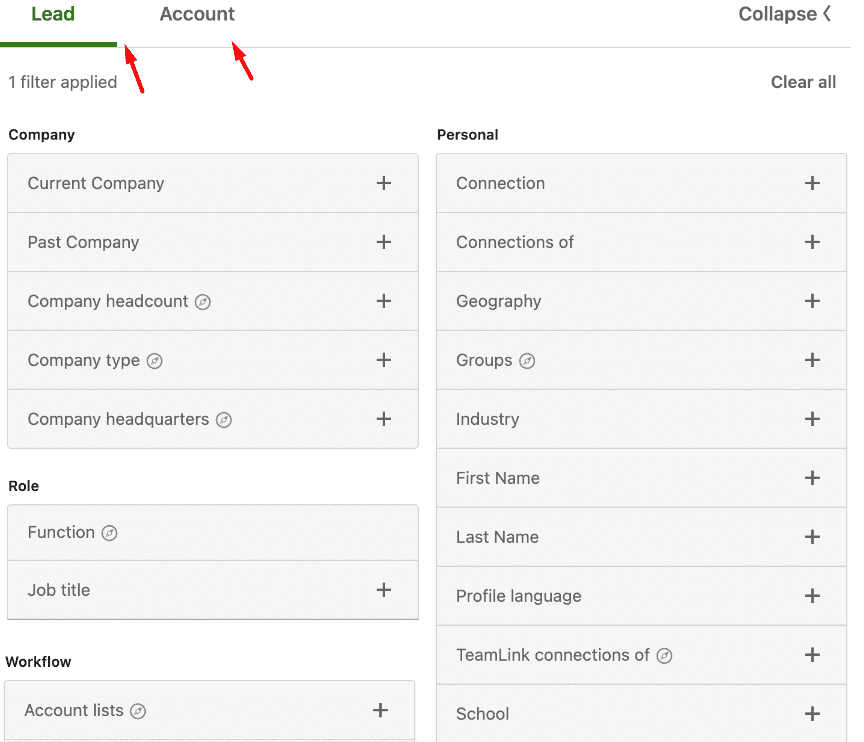
Once you have a list of your ideal prospects, copy that search URL for the next step.
2. Lead generation using Skylead
Once you have shortlisted your leads, you can create your outreach campaign.
As we said, you can use the different outreach tools. However, to demonstrate how to create a campaign, we’ll use our LinkedIn automation tool and cold email software, Skylead.
Go to your campaign dashboard and hit the Create campaign button.

Choose among various sources to import leads into your campaign, and paste the URL you saved from the previous step. Next, name your campaign and move on to the following step.
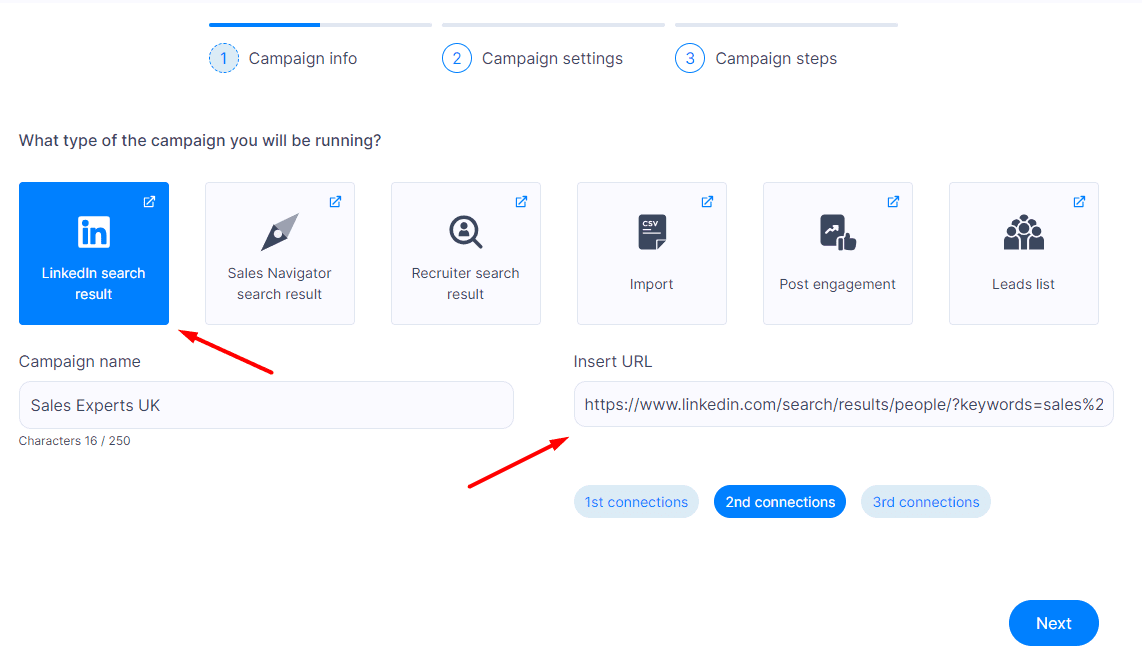
Here, you can set your additional email and LinkedIn settings.
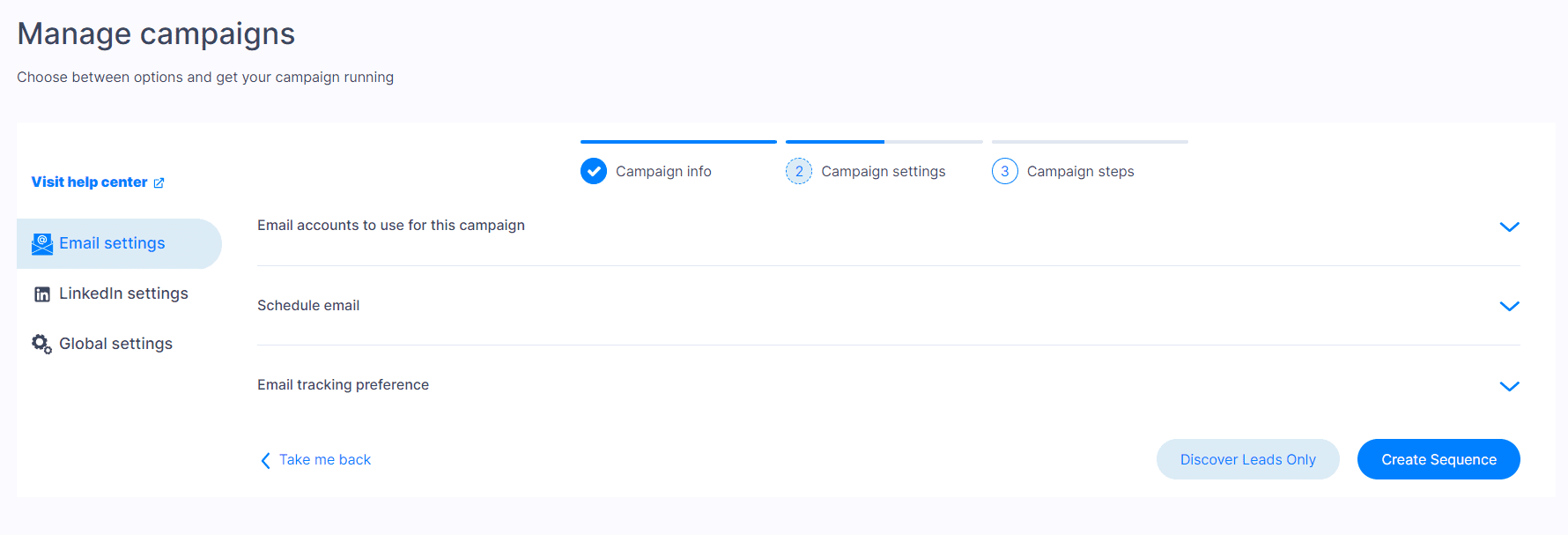
One of Skylead's feature is that you can add unlimited email accounts at no extra cost. Then, you can select all the emails you added, and Skylead will rotate them, bypassing the email limit. In other words, you can send thousands of emails and reach more leads faster.
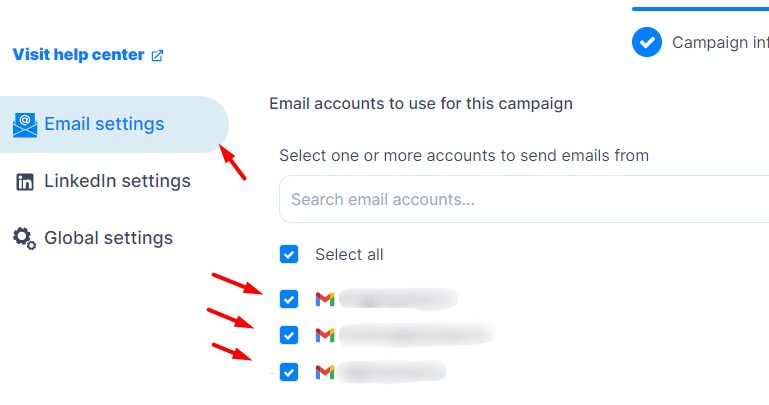
When you've finished tweaking your settings, hit Create Sequence.
This is a page where you create your Smart sequence. To clarify, a smart sequence is an algorithm you create, and Skylead will follow it to reach out to your leads, making your outreach more efficient and targeted.
To create one, drag and drop steps and conditions to create different scenarios, and Skylead will execute steps depending on each lead's behavior. However, if this is your first outreach campaign and you're unsure how to create one, use our proven Smart sequence templates.
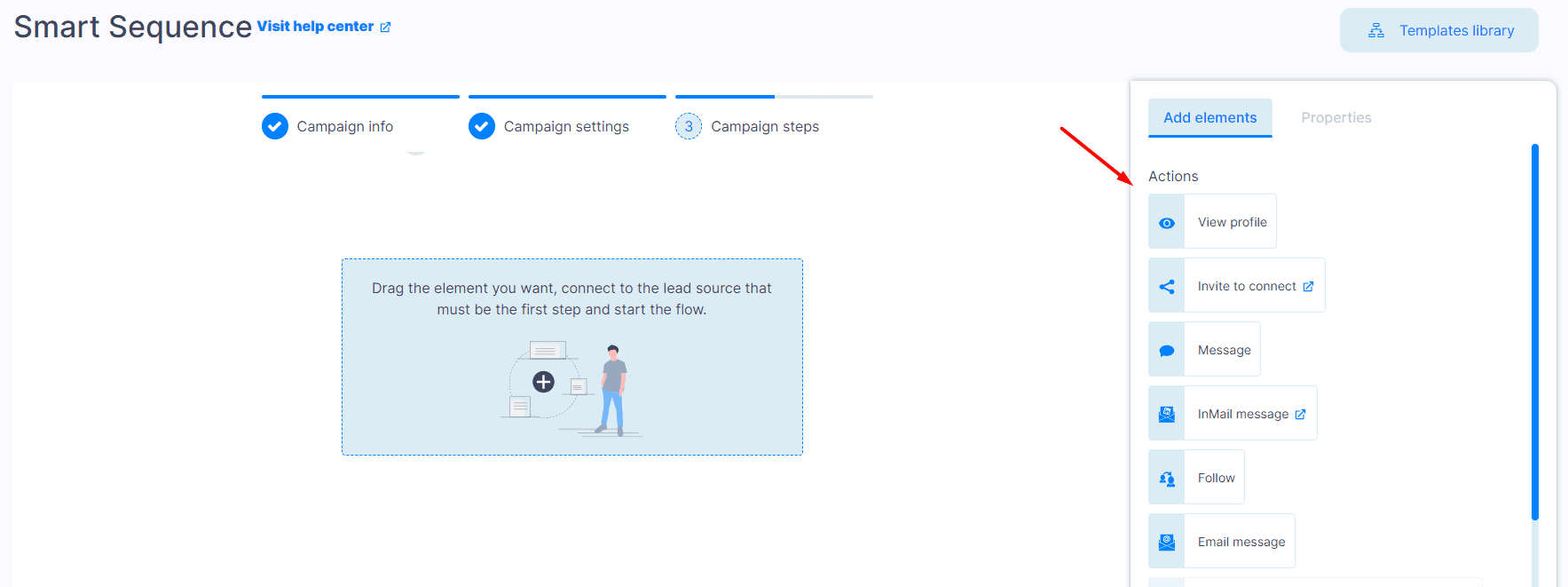
Your finished sequence should look something like this.
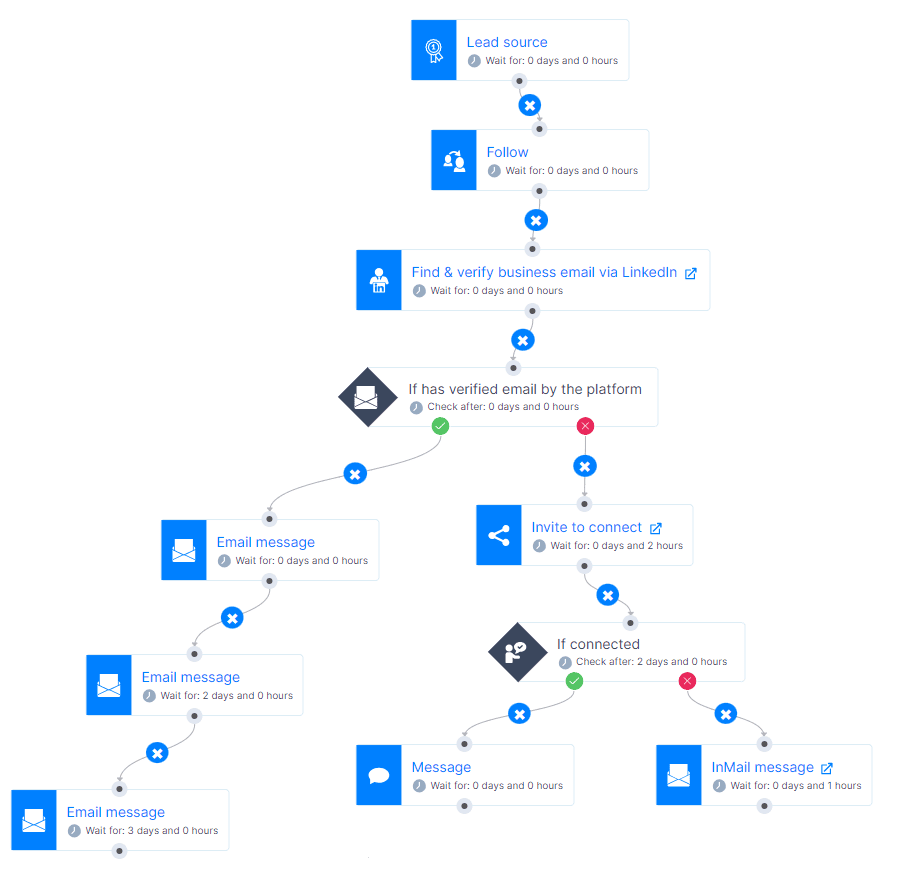
To make your lead acquisition process successful, personalize your outreach messages with variables such as the prospect’s name, company, etc.
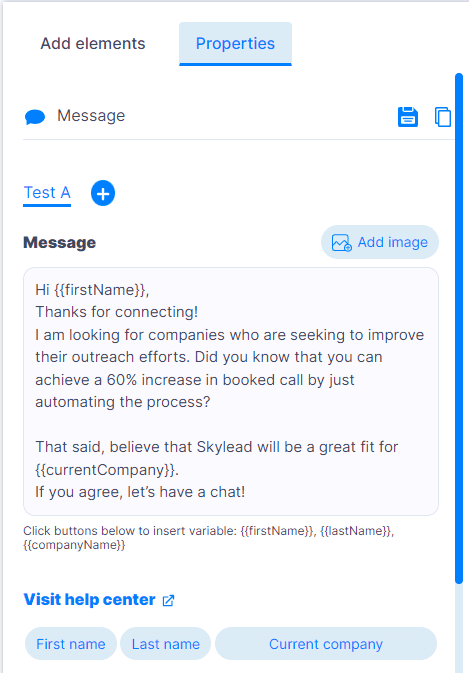
We also advise including personalized images and GIFs to stand out and get a higher response rate.
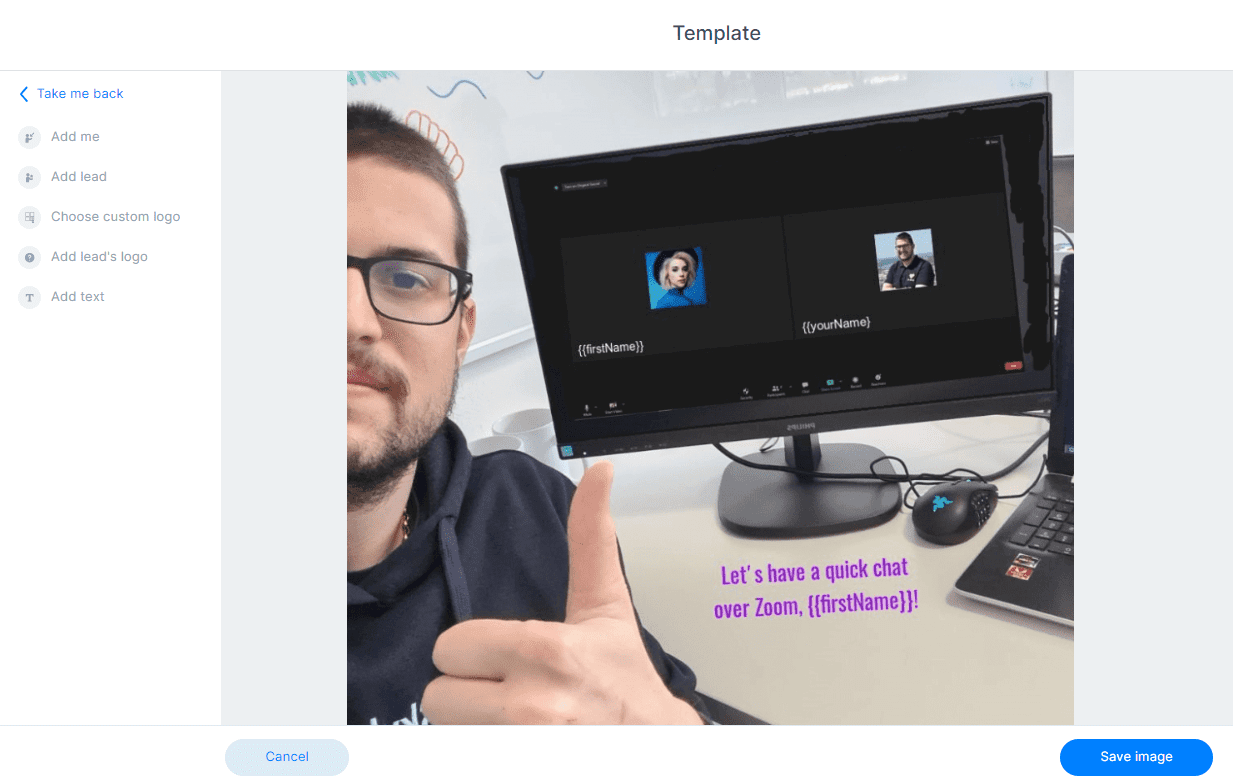
Once your messages are in place, the only thing left to do is to hit the Start campaign and watch the magic happen!
3. Utilizing CRM and Smart inbox to nurture leads
Once your campaign is live and the leads start responding, go to Skylead's Smart Inbox page. Here, you can manage all of your prospects' LinkedIn and email messages. This way, you can interact with them, nurture and convert without navigating between different platforms.
Moreover, you can save reply templates for quicker replies and create labels to prioritize leads. It's as simple as that.

If you feel you need more organization with your leads, you can also use a CRM system to keep track of them.
Why should your business choose a lead generation tool as part of your lead acquisition process?
If you're a business looking to generate leads, you have two options:
- manual lead generation
- or choosing automated tools to do it for you.
However, there are several reasons why automated tools may be a better choice for you.
1. You’ll get better ROI.
Firstly, Using an automated outreach tool as a part of your lead acquisition process can significantly enhance your return on investment (ROI). These tools streamline connecting with potential clients by automating repetitive tasks, allowing your team to focus on more strategic activities.
Automated outreach tools increase engagement rates and conversion potential by ensuring timely, consistent, and personalized communication. This efficiency not only saves time and reduces labor costs but also maximizes the impact of your marketing efforts, ultimately leading to higher ROI.
2. You’ll receive stronger opportunities for lead development.
Secondly, lead acquisition provides stronger opportunities for lead development. Acquired leads often come with a higher level of engagement and interest. Thus, your sales and marketing teams will have more to work with in terms of nurturing and conversion.
3. Lead acquisition becomes more cost-efficient.
Additionally, lead acquisition becomes more cost-efficient because acquiring leads through outreach tools come at a fraction of the cost.
This cost-effectiveness allows businesses to stretch their budgets further and allocate resources more strategically.
4. You’ll get more time to nurture your leads.
By streamlining a part of the acquisition process, you can devote valuable resources to building relationships and guiding prospects through the sales funnel. This allows for a more personalized approach, resulting in higher conversion rates and increased customer loyalty.
5. You’ll get more control.
Finally, automating a part of lead acquisition gives you more control over your LinkedIn lead generation efforts and ability to scale.
What is the lead acquisition cost? Lead acquisition cost formula
Lead acquisition cost (LAC) refers to the expenditure incurred in acquiring a new lead for a business. It encompasses all expenses associated with attracting, capturing, and nurturing leads until they become customers.
The formula for determining LAC is relatively straightforward:
- divide the total cost of lead generation activities by the number of leads generated within a specific period.
| LAC = Total Cost of Lead Generation Activities / Number of Leads Generated |
To compute LAC accurately, start by identifying all costs related to lead generation, including,
- advertising expenses,
- marketing software subscriptions,
- personnel salaries,
- Sales-related expenses
- Tools and resources used for lead generation
- and any other relevant overhead costs.
Then, sum up these costs to obtain the total expenditure.
Next, tally the number of leads generated during the same timeframe.
Finally, divide the total cost by the number of leads to derive the LAC per lead.
Lead acquisition Vs. Customer acquisition - Differences
Lead acquisition is a subset of customer acquisition. Lead acquisition focuses on identifying and gathering information about potential customers (leads) who have shown interest in your product or service. This process involves activities such as generating interest, capturing contact details, and nurturing these leads until they are ready to make a purchase decision.
Customer acquisition, on the other hand, encompasses the entire process of converting leads into paying customers. It includes lead acquisition as the initial step but goes further to involve strategies and activities aimed at nurturing leads, closing sales, and retaining customers.
Here are the core differences between lead acquisition and customer acquisition.

What are lead acquisition channels?
Lead acquisition channels are the different ways businesses attract, engage, and convert potential customers into sales.
Here are some of the lead acquisition channels you can opt for.
1. Email
Email is a powerful channel for acquiring leads and driving sales. It involves:
- Engaging prospects through various channels: Sending cold, personalized messages to your prospects via email, LinkedIn, etc.
- Sending targeted content: Delivering newsletters, and promotional offers to nurture leads and turn them into customers over time.
2. Organic Social Media interaction
Social media platforms like Facebook, Twitter, LinkedIn, and Instagram play an important role in reaching potential customers. Sales teams can leverage social media by:
- Sharing helpful content: Providing value to their audience as individuals and nurturing connections that lead to sales.
- Interacting with the leads: Engaging with your prospects to build relationships and trust.
As a go to strategy, you can simply use and rely on LinkedIn as a lead acquisition channel.
LinkedIn has proven to be highly effective for B2B lead prospecting and generation. Its professional network offers unparalleled opportunities for businesses to connect with potential clients, establish thought leadership, and generate quality leads.
You can share helpful content regarding your services or portray the problem-solving nature of your product. And then, share that helpful content with potential prospects to build trust and credibility.
3. Social Media advertising
For marketing teams, advertising compliments organic social media efforts by:
- Targeting specific demographics and interests: Reaching potential customers with custom ads.
- Boosting visibility: Increasing brand awareness and driving traffic to generate leads.
4. Search engine optimization [SEO]
Another great channel for attracting customers is through online searches. By optimizing website content to match search intent, businesses can:
- Appear higher in search results: Increasing visibility and attracting more visitors.
- Generate more leads and sales: Capturing the attention of potential customers at the right moment.
Each of these lead acquisition channels plays a vital role in the sales process, from attracting potential customers to converting them into paying clients.
Why is it hard to acquire leads?
It's challenging to acquire leads due to various factors. Marketers face difficulties in capturing potential customers' attention amidst the vast array of marketing channels available.
Cold calls, once a common tactic, are now largely ignored, with 97% of recipients disregarding them. Generating leads also requires investment; the mean cost per lead across industries is $198.44.
Additionally, not all organizations have a clear understanding of their lead generation efforts, with 12% of marketers admitting uncertainty about the number of leads they generate. Moreover, accessing accurate data is crucial for effective lead generation, yet nearly 40% of marketers believe their efforts could improve with better data.
Lead quality is another concern, with sales teams frequently encountering issues such as poor lead readiness to buy or difficulty in contacting leads.
Time constraints pose a significant challenge as well, with sales reps often too busy to promptly follow up with leads, hindering the conversion process.
Why does lead acquisition matter?
One key reason why lead acquisition matters is its direct impact on sales revenue.
When a company gets leads, it increases its chances of turning potential customers into paying ones. Also, good ways of getting leads help companies get more customers and find new markets. If a company doesn't consistently get leads, it might struggle to make sales and keep up with other businesses.
That's why businesses of all sizes utilize automated tools to streamline their sales processes. And this is where Skylead comes in to manage your lead acquisition process effectively!
Register for a free trial today and take your lead acquisition to new heights with Skylead by your side!
When talking to prospects, sales reps know that the art of selling revolves around many skills. However, the most important one, hands down, is objection handling.
Prospects might give you many reasons why they don’t need your product/service, from “it’s too expensive,” “I don’t have time,” to “I’m happy with your competitor.” Ouch! We know–it might hurt, but your job is to overcome these obstacles.
But how to turn a “no” into a “yes”? To teach you how to do it, we are drawing from years of our own sales experience to show you:
- Types of objection handling
- A 7-step guide to master handling in sales
- Top 17 objection-handling situations with winning rebuttal examples
What is objection handling in sales?
Objection handling is the process of addressing concerns or doubts raised by a prospect. It uses empathetic listening and other communication techniques to provide solutions or reassurance, with the goal of maintaining a positive relationship and moving closer to a more successful outcome or sale.
Objections may come up for various reasons:
- Poor LinkedIn prospecting
- Failing to find your Ideal customer profile or Buyer Persona from LinkedIn lead generation.
Of course, it could be none of the above. You could have done everything right, yet objections may pop up to create very common outreach obstacles like:
- Inadequate price
- Lack of authority
- Competitors
Why is objection handling important?
Imagine a world where no objection is handled - there would be no deals or revenue at the first mention of a problem or concern. It’s important for salespeople to address these objections properly so the prospect will move through the sales pipeline and convert. But why do objections show up in the first place?
An objection usually appears because there is not enough trust. It’s important to build trust by addressing your prospects’ issues on time, which helps nurture your relationship with them. This can ultimately lead to multiple sales in the future.
Our best advice is not to avoid objections but to use them as a tool to build a stronger relationship with your prospect. You can regularly check up on your prospects' sales journey and find out if there’s any doubt to address by asking questions such as:
- Do you have any concerns about X?
- Is there anything you are worried about regarding X and why?
- Is there any obstacle that would be a deal-breaker and would stop you from using [product/service]?
Types of sales objections
Before we get into the how let’s go over the three common types of objections sales reps encounter on a daily basis in outreach. 👇
Solution-oriented sales objection
When the prospect has a problem, and your product/service can solve the problem, but they’re unsure whether to go for it or not, that is called a solution sales objection type. Andrea, our Head of Sales, says that this is the most common type of objection, and in this case, your job is to persuade the prospect that your product/service is the perfect solution for them.
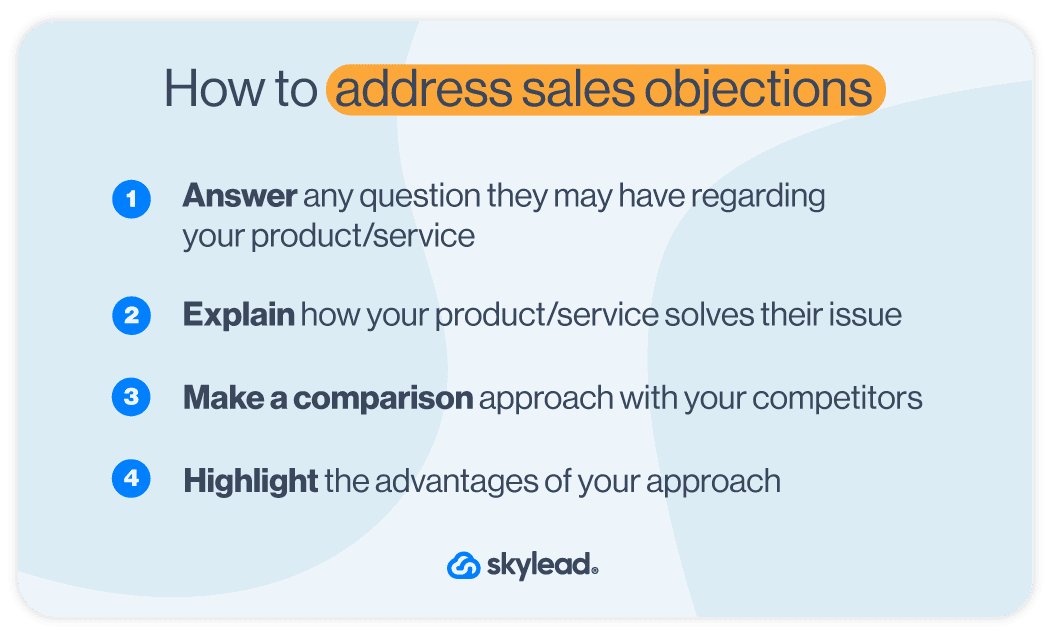
No-problem sales objection
Next, we have the so-called “no-problem” sales objection type. In this situation, the prospect doesn’t perceive the problem as a big deal–in fact, it doesn’t concern him as much. This is a situation where you have to create a sense of urgency and subtly present your product/service as the only solution.
How did this happen? Well, our Account executive, Pavle, says that this objective type might pop up when you show the prospect all features and benefits immediately or without actively listening to what they see as a more important issue.
Problem-oriented sales objection
The hardest one to overcome is the problem-oriented sales objection—the case where the prospect has legitimate issues and doesn’t see how your product/service solves them.
If this is the case, we advise you to first determine if your product can actually help. If it doesn’t, it’s better to be honest with the prospect. This way, you’re actually building a positive relationship that might turn into a good recommendation or a potential future collaboration. However, if it does help, make sure to offer your product and depict it as the logical solution to their pain point.
7 steps to overcome sales objections
Now, let’s look at the tested and trialed steps our sales team always uses when addressing doubts and objections with prospects. 👇
1. Actively listen to prospects
Our Andrea says that to be a successful salesperson, you must learn how to listen rather than reply. Active listening can be described as the most important skill a salesperson should have.
Most of the sales processes nowadays happen remotely and online, so salespeople don’t have the luxury of reading into body language or even tone of voice. The only thing they have is their digital written replies, which is why listening carefully can improve your relationship with the prospect and ultimately lead to a conversion.
2. Repeat what you hear
Since there’s usually no physical interaction between you and your prospect, it’s important that you phrase your questions and answers in a way that replaces a specific reassuring tone of voice and microexpressions on your face. So, when a prospect voices an objection, make sure to repeat it back to them for two reasons:
- To make sure you understand their issue correctly which can help you change their mind later.
- To make them feel valued and heard by you, which builds trust further.
3. Validate concerns
This step comes after you’re sure you understand your prospect’s worries. From this point, you can continue building trust with them by empathizing and showing them you understand their viewpoint. By validating their concerns, you can lead them to the part where you unobtrusively introduce your product/service as a proper solution.
This is how validating concerns looks like in real life:
I understand that implementing a new tool can lead to a rocky adaptation period. Luckily, our all-star support team is here to help ease the transition and get you to operate as before but better.
4. Ask open-ended follow-up questions
When an objection comes in front of your potential sale, your main job is to keep the conversation going. To keep them engaged, be sure to ask follow-up questions. However, you should avoid questions that can be answered with “no” or “yes”.
Instead, focus on open-ended questions that allow your lead to keep communicating their thoughts and worries so you can address them as soon as possible. The more information they give you, the more material you will have to turn the objection around into a sale.
Can you walk me through some of the challenges you're currently facing in managing your {{process/Task}} and how you see the perfect solution to improving your situation?
5. Use social proof
When in doubt, use social proof to change your prospect’s mind. The best way to persuade them is to showcase a customer story, case study, or data addressing their pain points.
Here’s an example of a case where your social proof addresses their objection or pain point:

6. Give them time to think before your next follow-up
In objection handling, there will be situations where your prospect will ask you to give them some time and space to think about their options or to restart the conversation in the future. Your job here is to give them enough time and space but not too much. If you leave them for too long, they might lose track of you and your product/service, and this is why a follow-up that restarts the conversation is an absolute must!
So, be sure to set a time that isn’t too far in the future, and make sure to let your prospect know that you will answer any questions and discuss any news regarding your product/service.
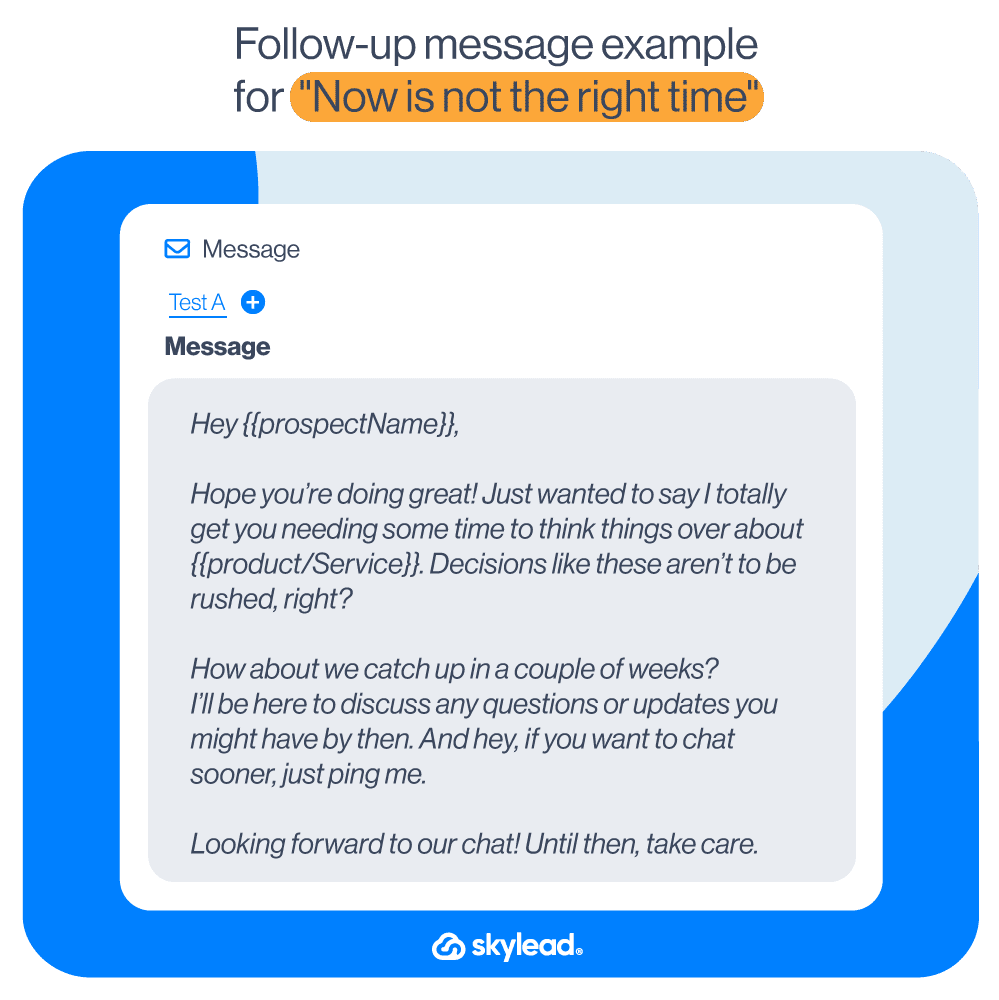
7. Address objections before the prospect does
Ultimately, a good salesperson is the one who can predict and cover potential objections and worries before the prospect mentions them. If you’re working in a certain field and with prospects from a certain industry, you most likely are already familiar with the type of worries that might come up, so it’s good to sew in subtle objection-handling cues into your sales pitch.
Top 17 objection-handling situations with rebuttal examples
Now that we’ve covered why it’s important, the types of objections out there, and our 7-step guide on how to handle and overcome objections, it’s time to look at the 17 most common objections. Our superstar sales team came together to tell us all about the reasons they had to work around over the years. Let’s begin handling objections. ⬇️
#1 I already have a solution
This one is the most common objection, and it usually involves your direct or indirect competitor. The way to work around this is to find your prospect’s pain point that their current solutions don't solve. Depending on how the prospect ends the sentence, your response may vary, so let’s see all the potential scenarios.
Rebuttal examples
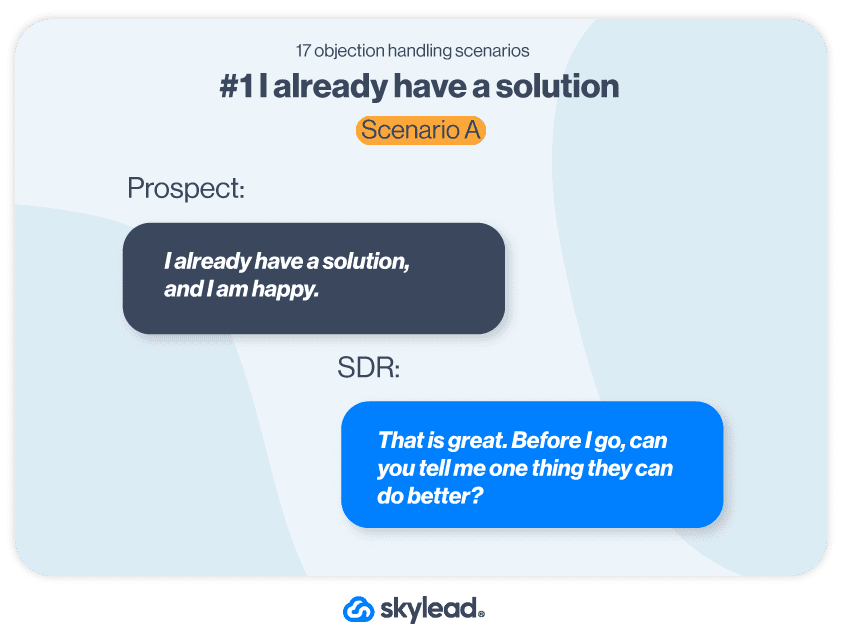
Tease out why they think the solution is good for them, and gather the pain points based on which you can book a meeting. If their feature is really better, leverage the one your product has and think it’s better for the prospect’s business.
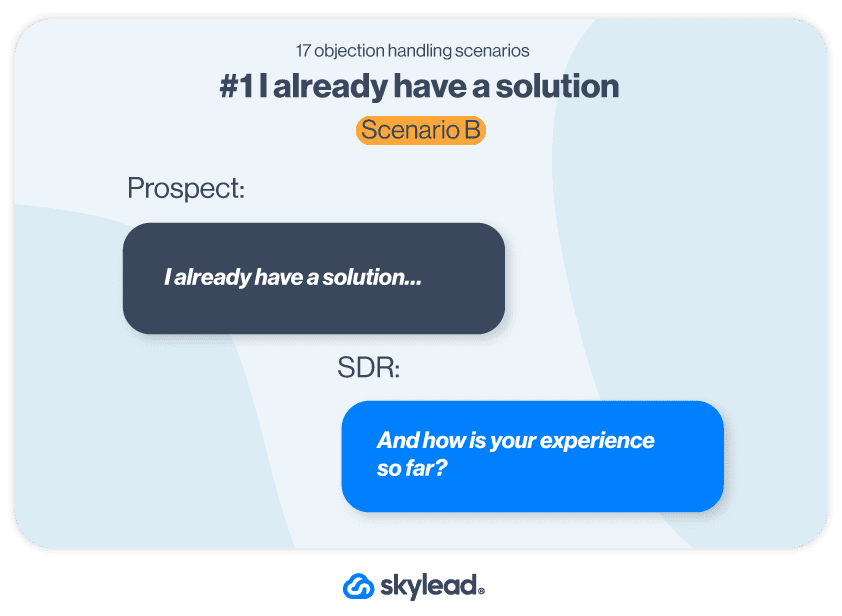
Tease pain points to continue the conversion. Pausing may imply that they are not satisfied with something. Then it’s your job to figure out which part the competitor isn’t covering so you can sweep in and solve the problem.
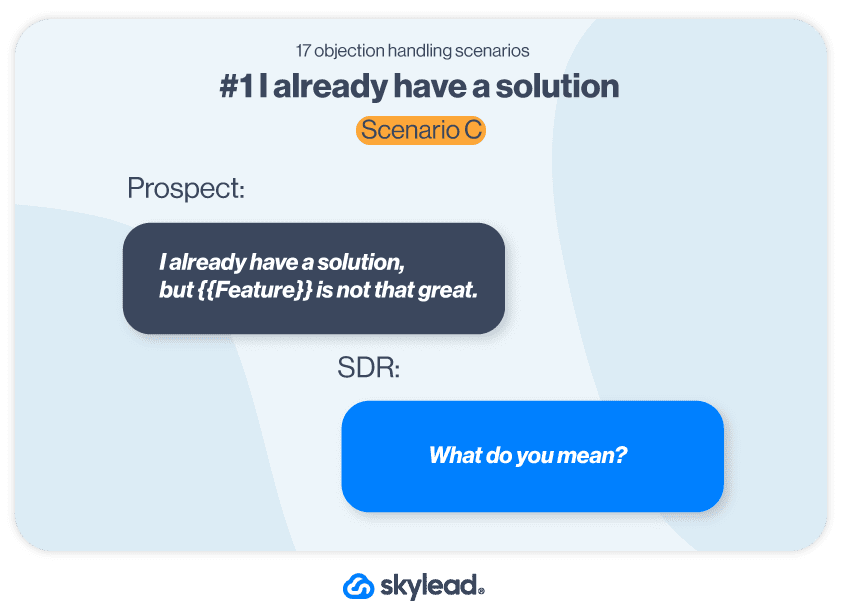
Needless to say this is the best answer you can get, as the prospect immediately pointed out the pain point. Ask more questions, empathize with them, and then underline the value of your product/service to move the conversion process forward.
#2 I am not the right person
From Becc Holland’s experience, the CEO and founder at Flip the Script, sometimes, in cold outreach, you will talk to people who are not the decision-makers. From our experience, if you build a good initial relationship with them, they could point you to, or even connect you with the decision-maker, so don’t dismiss them right away!
Rebuttal examples
Make sure to listen or read carefully if they are indeed the right person or not.
If they are but say they aren’t just to chase you away, structure your objection handling response like this:
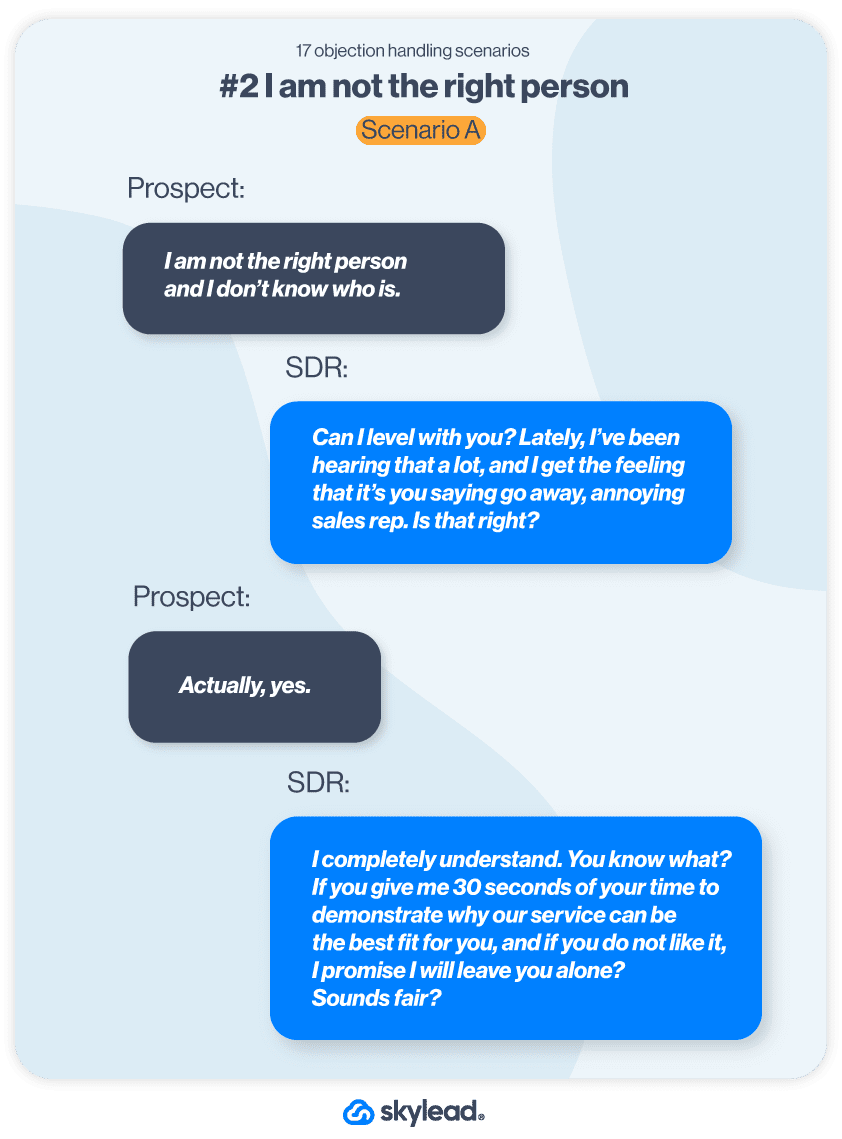
After you ask for consent to pitch and they give it to you, pitch a unique selling point and value proposition to try to close the deal or schedule a demo call.
In case they're not the right person, structure your response like this:

If you find the decision maker, you can always reference the person you spoke with first. If you don't succeed, you can reach back to the first person and ask for additional advice or to point you to the right person.

However, if you can’t reach the decision-maker, reach back to the first person and give them an update. Be honest, admit you might have made a mistake, and ask for advice again. The first person will probably want to make things right and reach the decision-maker themselves.
#3 I don’t have time
As an SDR, your job is to prove to your prospects that you are worth their time. For example, by using short sentences you’re showing you respect their time. You will also catch their attention by showcasing the experience of similar people, and then ask for a fragment of their time to pitch or aim to schedule a call for another time.
Rebuttal examples
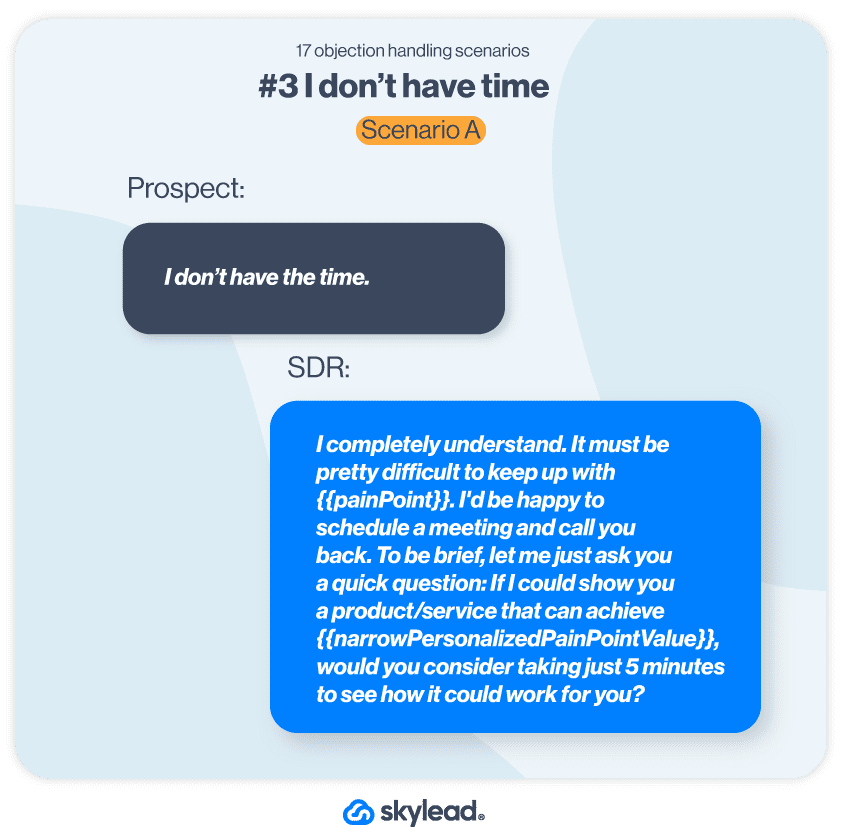
With this question, you are providing the value and solution right away and showing you are respecting their time. They may or may not have the time right now, but you teased enough to schedule a call another time and soon. Ask them again if they have that 5 minutes right now, or if they do not, when you should schedule a short call.

With this statement, you get the chance to pitch right away, so try to be as brief as possible, and finish by asking for another call.
#4 The budget is a little tight at the moment
Price objections are the type of sales objections you want to hear, as it shows the prospect thought of buying your product/service, but had to reconsider because of the price. These prospects usually need a little nudge value-wise and they’ll convert.
Rebuttal example
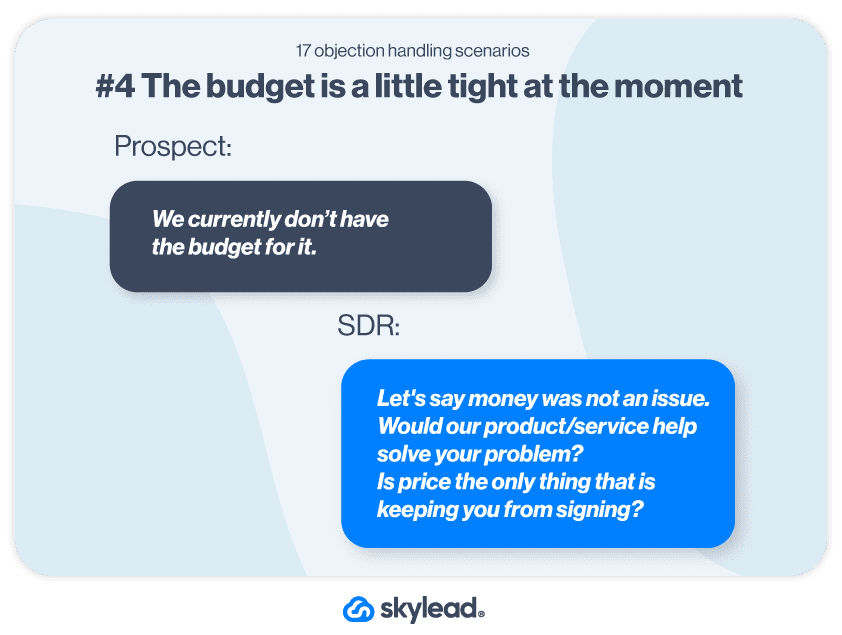
If the answer is yes, you have the opportunity to offer a discount code to push them towards the closing process. If not, ask more questions to find out the real reason, then leverage it to remove it with personalized value.
#5 You are more expensive than your competitors
Similar to the previous one, this objection has the money issue involved, but with an added spicy competitor comment. Try to stay calm as this is solvable 90% of the time. You overturn this by showing how they can win with your product as opposed to losing with the cheaper alternative.
Rebuttal example
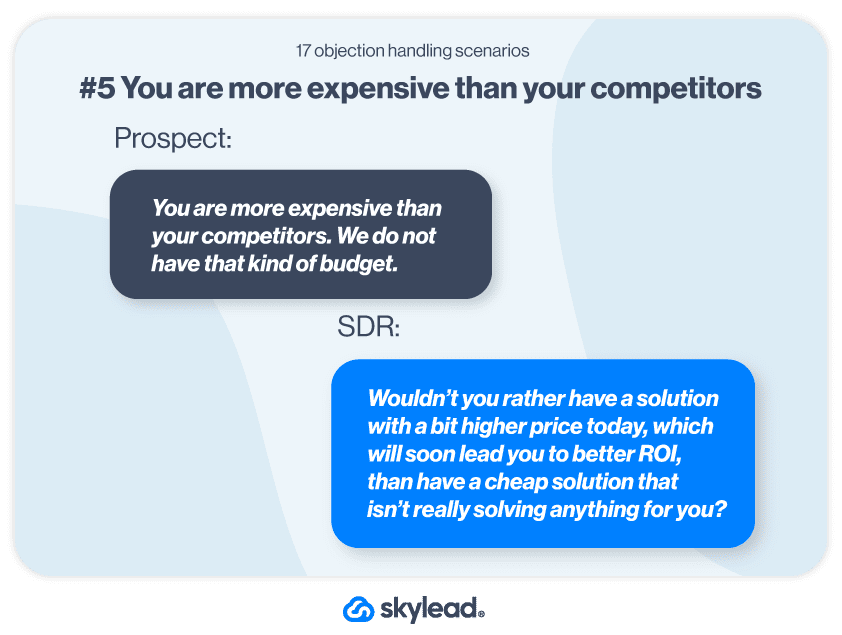
The moment you start justifying the price, you’re bargaining with the prospect. Rather than addressing the price issue alone, our Andrea says that you should link the price to the higher value that your product offers. If they still don’t understand, then they probably do not match your Ideal Customer Profile.
#6 I need to check with the boss, or my boss doesn’t like this product, but I do
Sometimes, the person you are pitching to will not have the authority to make final decisions. However, you should not lose interest in pitching to this person, as they might be the ones who will use the product in the end. If you make a good impression, they might pitch it to their boss, and the conversation and the conversion will continue.

Rebuttal examples
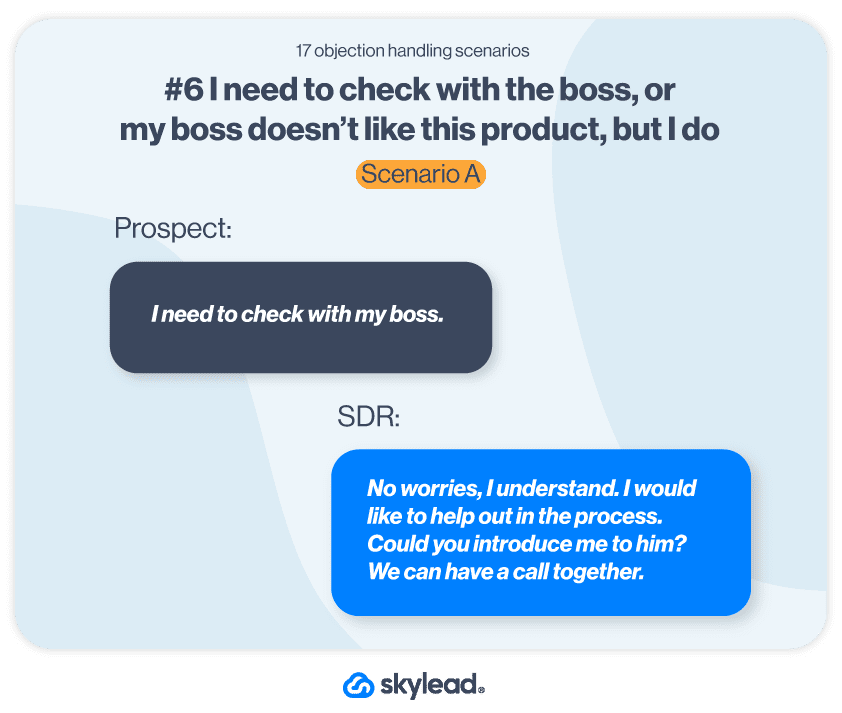
Andrea says that you shouldn’t never allow anyone else to deliver your sales pitch to the decision-maker. Instead, aim to schedule a call with them to provide value. Be careful not to make the person not in charge feel inferior, though. So, instead offer them help and support in the pitching process. If they don’t want to schedule the call, offer to send the necessary info.

Give them the exact metric of the value your product offers so that the person can use that as leverage to schedule a call with their boss.
#7 Reach out to me next month/year
Sometimes the prospects will be busy with their heavy workloads. In this situation, you should approach by explaining that you understand. Also, highlight the fact that your product/service can actually help them and improve their work experience.
Rebuttal example
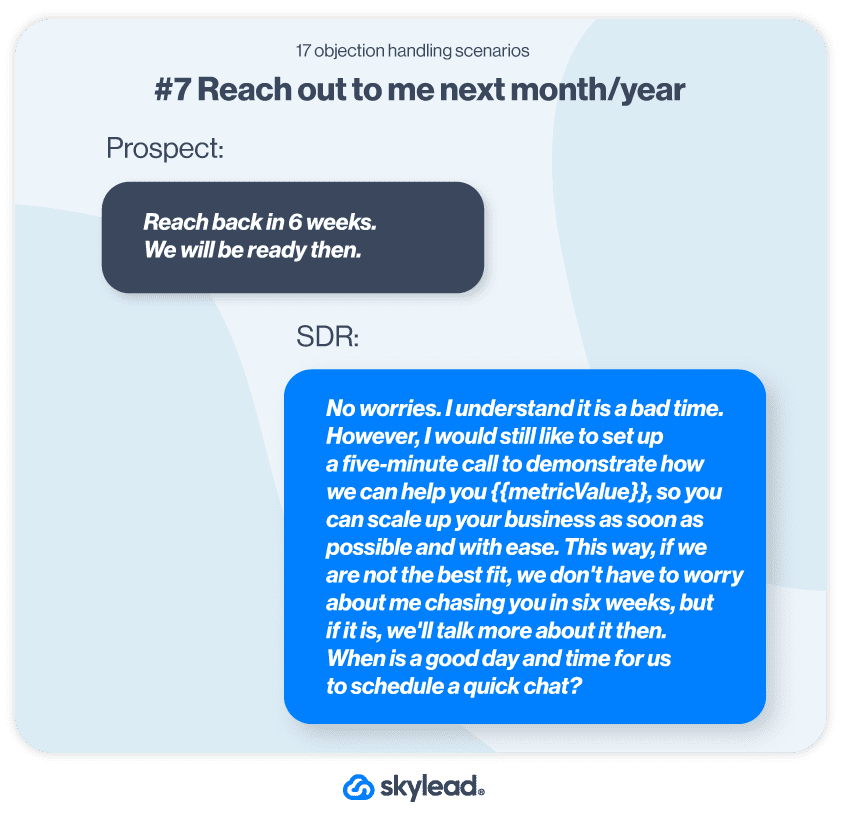
Reassure them that this is not a buying conversation. You just want to show them how valuable your product is and what it can do for them right away.
#8 Send info over the email
This is a common objection when cold calling or after a demo. In most cases, this means that the prospect has already made up their mind. By asking you to send more information, they hope to cut the conversation short. Don’t let that get to you. 👇
Rebuttal example
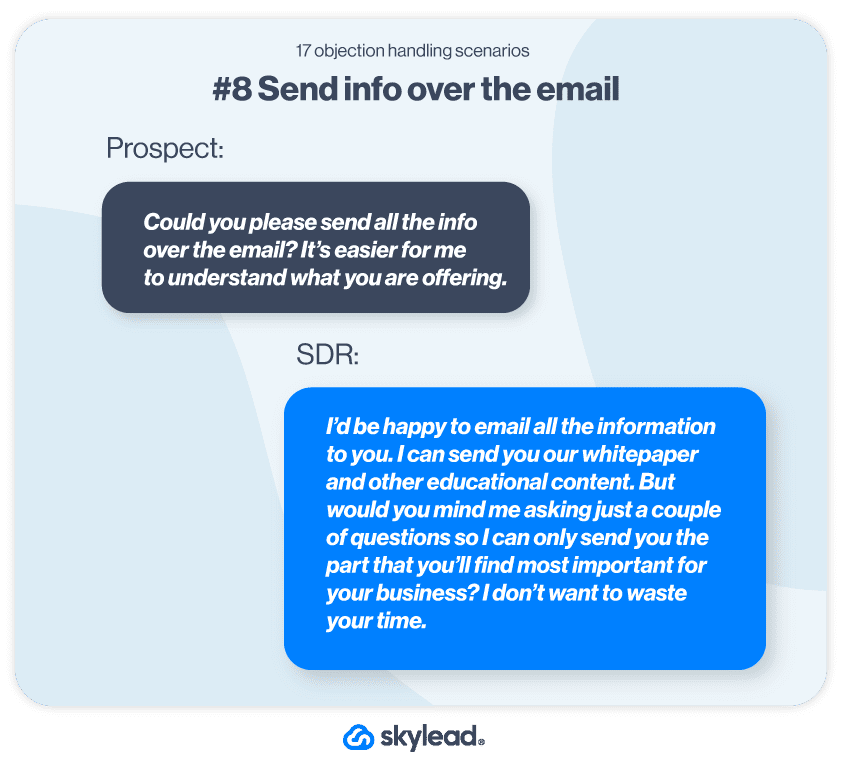
Agree to send the information, but not before asking questions about their business to understand their pain point better.
#9 I’m not interested in your offer
Ouch! This objection is also a pretty common one, but again, you should not let it throw you off your game. You should ask yourself this: How are they not interested if they didn’t even hear your offer? The truth is that this objection usually means that they are busy. Turn it to your advantage by restructuring your introduction to focus on the expertise.
Rebuttal example
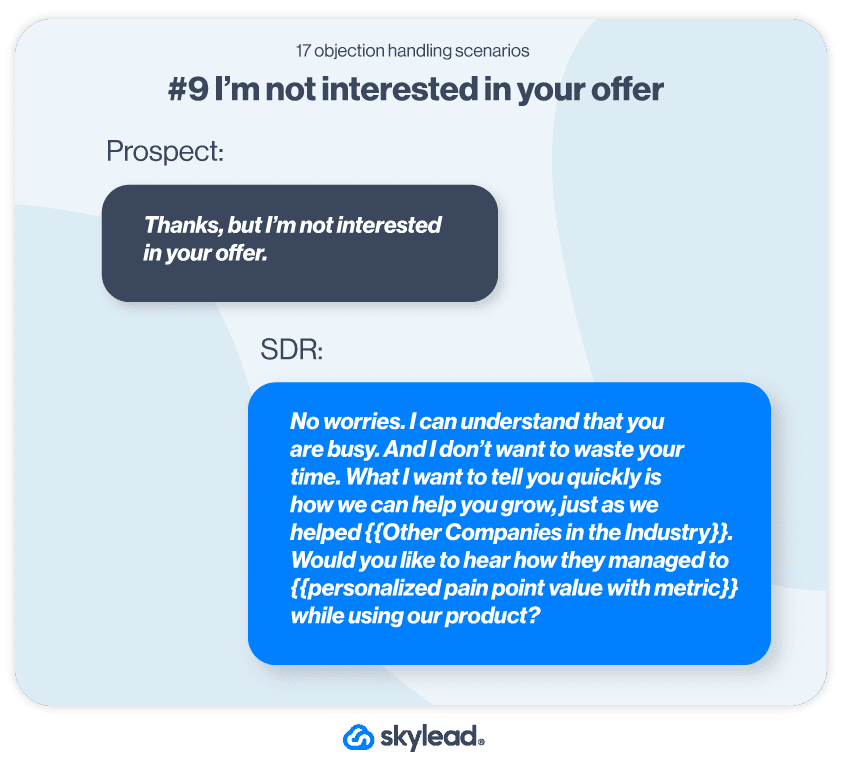
Try to keep the conversation going, just so you can demonstrate expertise using their pain point. This way, your prospect can see that you have relevant experience to back up your claims and that you know your worth. A true objection handling win! 💪
#10 Pitching back
This is an objection that became pretty common nowadays. It’s when B2B companies pitch you back, usually on demo calls. Translation? They are not interested in your product/service - they are just using the chance to show you their own. The audacity, right?
There is nothing wrong with presenting your solution, but if they only agree to the call to pitch you back, that’s just sneaky.
Rebuttal example
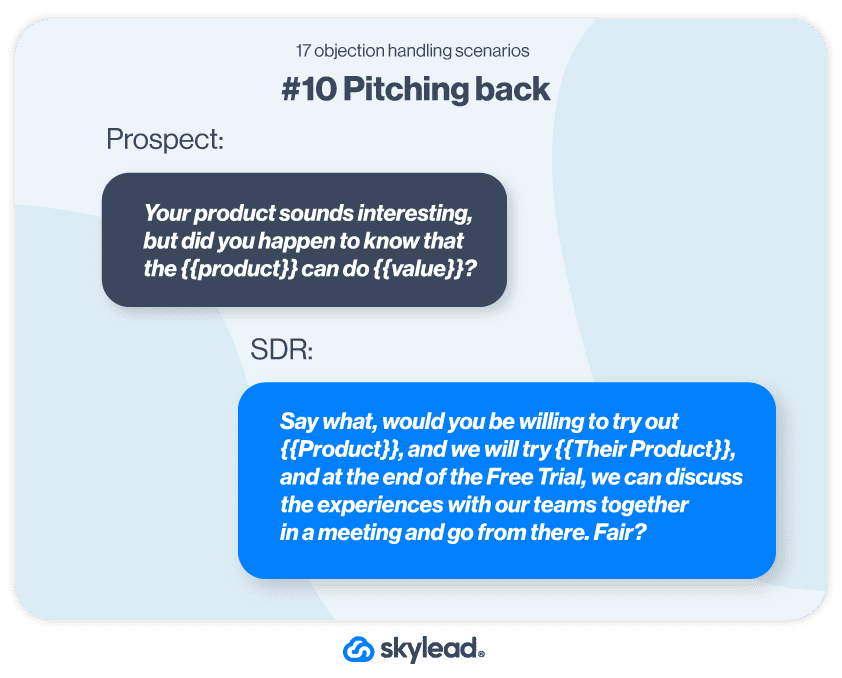
Proposing a collaboration will definitely catch them off guard, and there is a chance that their decision-maker will see the value you offer.
#11 Your product doesn't have {{feature}}, and we need it.
This objection could be a tricky one, but try to suggest an alternative solution used alongside yours. In case this need is a must for them and your product can’t solve it, then your prospect might not be the one for you. Before you write them off, try this 👇
Rebuttal example

#12 We're happy with the way things are now.
Sometimes, this could be the case. But that doesn’t mean you should believe them right away. Ask more questions to get into potential problems they might be facing. If the answer is still no, move on. ⏭️
Rebuttal example
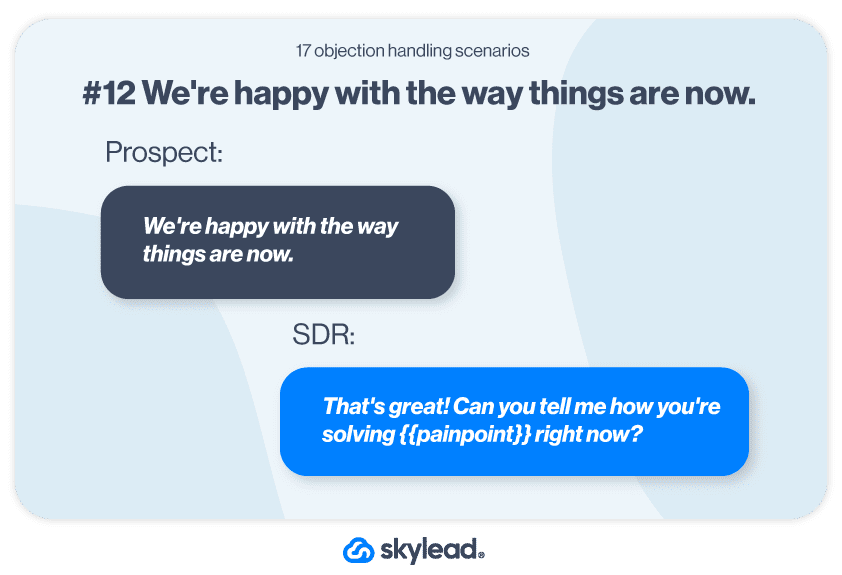
#13 Your product is too complicated.
In this case, make sure to ask questions and find out if a specific feature or the entire product is too complicated for them. In both cases, you should clarify any concern they might have and add that your customer support team will, by utilizing inbound call center software and other channels like chat, help them set everything up smoothly if they choose to buy.
Rebuttal example

#14 I don't see what your product could do for me.
This objection usually means there’s some information that needs to be presented. So, your job here is to confirm their goals and pain points, and then explain how your product/service fixes these issues for them.
Rebuttal example
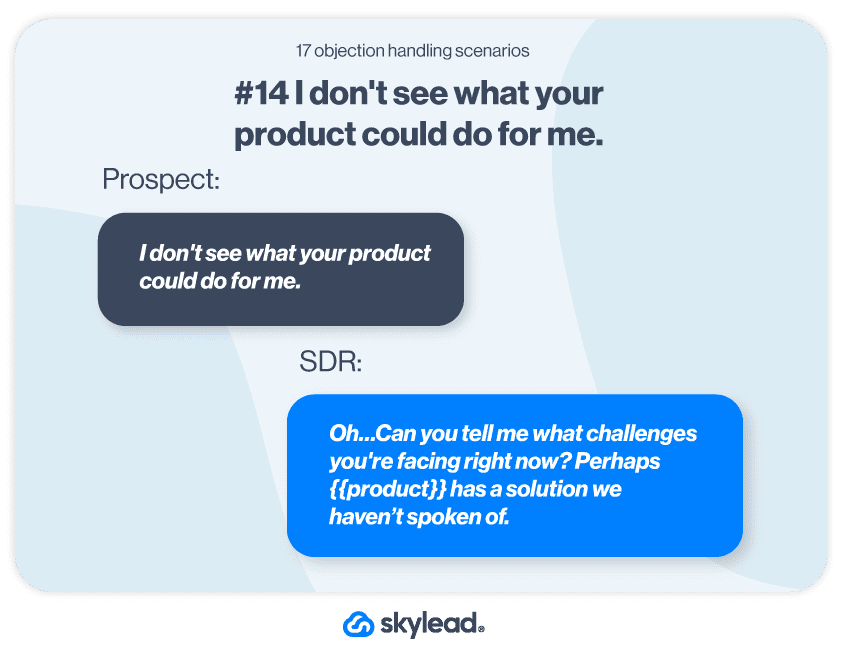
#15 {{Painpoint}} isn't important right now.
In this case, there might be two reasons the prospect is stating the objective. First, they might want to let you down easy, or you need to ask more questions to find out why this isn’t important right now, so you can explain why it’s a great time to rethink their priorities. Try to create a sense of urgency and work from there.
Rebuttal example
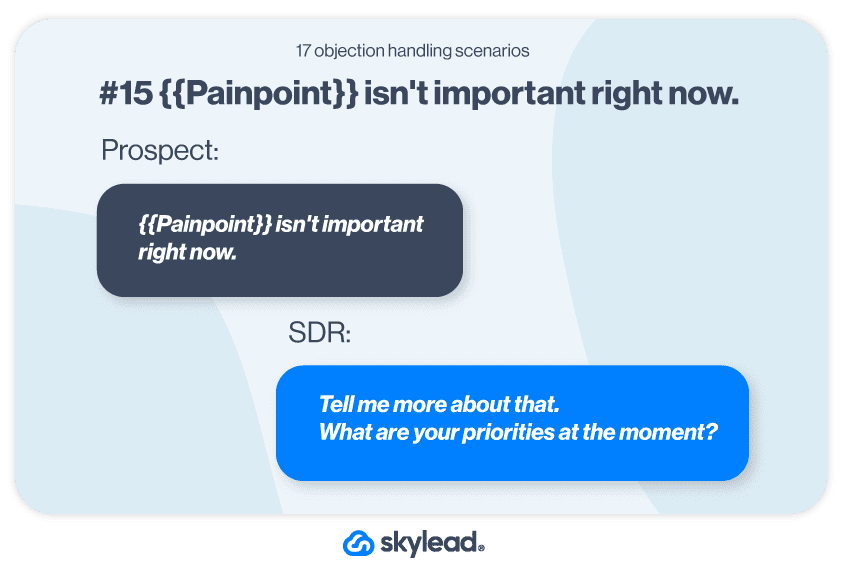
#16 I'm happy with {{competitor}}.
What do you do if the prospects say they’re happy? You don’t buy it! First you find out why they are content with the way your competition works for them. Second, try to identify potential weak points and subtly underline how your product solves them.
Rebuttal example
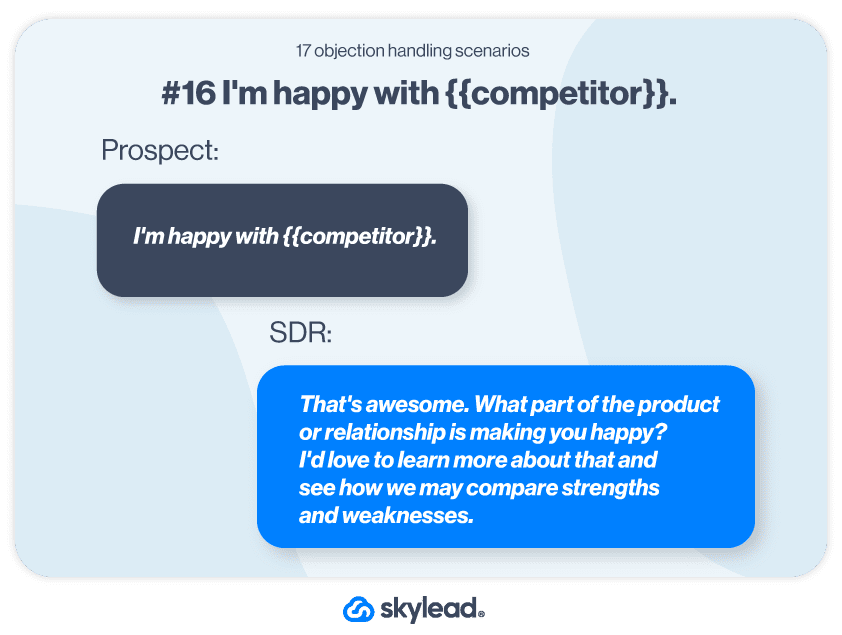
#17 We need to use that budget somewhere else.
If this objection shows up, your main goal should be to make them believe that the budget should be redirected, or rather, invested toward your product/service. This is where social proof comes in as your best friend, so don’t be afraid to throw around some numbers.
Rebuttal example
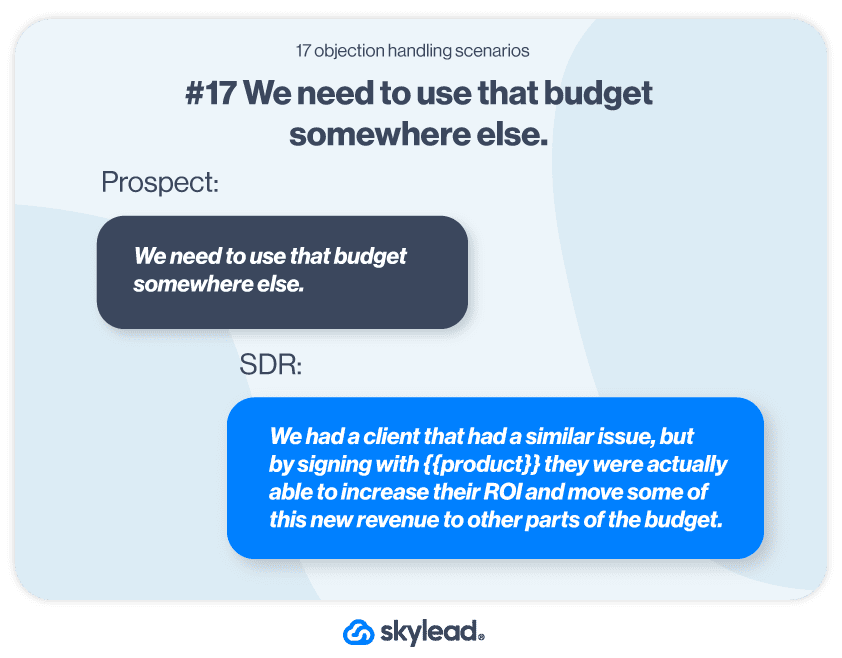
Frequently asked questions - FAQ
How do you tailor objection handling strategies for different industries or sectors?
Tailoring objection handling strategies to different industries or sectors requires an understanding of the unique challenges and needs of each market. For instance, objection handling in the tech industry often involves addressing concerns about integration and compatibility with existing systems, whereas in healthcare, the focus might be on compliance and patient privacy. Sales reps should research industry-specific pain points and prepare tailored responses that resonate with their audience.
Can objection handling techniques be applied to digital sales channels, like social media or email marketing, and if so, how?
When it comes to digital sales channels like social media or email marketing, objection handling techniques need to be adapted for the medium. Since direct interaction is limited, sales reps can use targeted content to preemptively address common objections. For example, FAQs, customer testimonials, and detailed product information can help overcome objections before they are even raised. Engaging with comments or inquiries promptly and thoughtfully on social media can also mirror the empathetic listening aspect of objection handling in a more public forum.
How do you measure the effectiveness of your objection handling efforts?
Measuring the effectiveness of objection handling efforts involves tracking sales metrics such as conversion rates, the number of objections encountered versus those successfully addressed, and customer feedback. Sales teams can conduct regular reviews of sales calls and meetings to identify patterns in objections and assess how well they are being handled. Customer feedback, through surveys or follow-up conversations, can provide valuable insights into whether objections were adequately addressed. Over time, this data can inform training and strategy adjustments to improve objection handling and, consequently, sales outcomes.
Ready to handle these objections with ease?
We know the answer: Yes, you are! With the knowledge we’ve gathered, you can up your sales game and handle objections like a pro. If you face an objection that gives you sales nightmares, you can always come back to this blog for inspiration on how to handle it.
Remember to collect all information and to approach each objection handling situation like you’re there to help them. That’s the only way you can build a solid relationship with your prospects. 🤝
So, before we let you go outreach away, we think you should also give Skylead a try and automate the outreach process while you’re at it. You’ll save lots of time, which you can use to build and nurture strong relationships with prospects.
The best thing about it is you can sign up for a 7-day free trial and check how the tool works with your own eyes. You won’t regret it, plus those objections will be easier to handle now that the tool is handling half of your workload. 👀
You’ve done a serious outreach effort.
You came up with a well-thought-of marketing strategy, engaging copy, and targeted leads meticulously.
Still, it hasn't brought the results you’ve expected.
How? You’ve followed every how-to guideline for successful outreach.
But have you read through a no-no manual as well?
Yeah. We thought so.
Inspired by our users’ questions and practices we read about on numerous Lead Generation discussion platforms, we decided to dedicate this blog to 6 common outreach mistakes that you are probably unaware of.
Not testing different channels
The most senseless mistake you can do in the times of sales engagement platforms and multichannel outreach is to rely on only one means of communication.
New approaches continue to arise and so should your business flexibility.
Don’t assume that a certain path of getting to your leads is the only one worth a shot just because it gave a positive outcome in the past.
Sure, there is nothing bad in going for what brought valuable results. But keep your mind open. Your perfect leads might be using other, already acclaimed or emerging, platforms as well. Testing them is the best way to find what works best for a particular campaign.
You would be surprised how going bold leads to conversions that otherwise wouldn’t happen.
Making it all about you
Your potential customers don’t care how something worked or played out for you.
They don’t want to listen to how awesome your product or service is unless you show how that awesomeness applies to them. Therefore, blurting out a rehearsed monologue about you and your product turns out to be a mistake that could cost you a valuable lead.
Prove to your customers that what you’re offering is a game-changer for them. It will solve their problems, spare their time and money, and make their lives better. This is how you earn somebody’s attention.
Therefore, when writing a product brief or an outreach copy, make sure to do your homework first. By approaching with a concrete solution to a challenging part of their business, you are more likely to be heard out. Even if they don’t buy something right away, your proposal will gain the advantage in the sea of impersonal offers.
Not taking into consideration a buyer’s journey
Not all people you reach out to or who visit your website are in the same stage of their buyer’s journey.
Some of them are in the phase of researching different options, some of them bumped into your brand for the very first time or heard about your company after you cold-outreached them, and now they are inquiring by checking out your online presence or asking questions to you directly.
Each lead needs to be approached depending on their buyer's journey.
Give a chance to those who are hearing from you for the very first time to learn more about your business. Asking them to make a purchase right away is one of the most common LinkedIn lead generation mistakes.
Those who already short-listed your company may want an educational kit, free course, templates, something that will provide them with industry valuable information.
Some of them will be ready for a demo.
Therefore, segment your leads depending on their buyer’s journey. Adjust your language and have different types of content ready to attach and offer. If someone doesn’t buy right away, it doesn’t mean you should write them off. Nurture those leads.
The feeling of being taken care of makes a difference.
Non-strategic CTAs
The research has shown that landing pages that have two or more call-to-action buttons help close fewer deals than the ones with only one, clear CTA, usually at the end.
That is, the website visitor gets distracted when bombarded with too many invites to purchase or book a demo. The same stands for an outreach message. It is far more effective to write an engaging and well-thought-of copy first and then leave a clear call to action for the end. If you keep your CTA the main focus, it is more likely people will click on it.
On the other hand, not putting a CTA on a page is a big mistake. When a website visitor gets informed about your product or service, they should not browse around and search for a call to action.
First of all, it costs you nothing to put one on each landing page. Second of all, it takes a second for your lead to lose interest. Imagine if you had to give someone your money and put an effort into finding a way to do it?
Making assumptions about your audience
You are not your client. And you are biased.
Prospecting on LinkedIn, or anywhere for that matter, on the assumption that you know what they need is a big mistake.
Instead, reach out and talk to your leads first. Find out what they like or dislike, get into discussions with them, and collect valuable information before you even mention your product.
Not only will you gain more insight into the market you are trying to get into but will know how to position your brand and customize your service to your client’s best interest.
This brings us back to the above-mentioned mistake #2 - making it all about you. Just forget about it. There are so many other companies out there providing the same service. Unless you prove that you genuinely care, you will be positioned low on the list of available options.
Asking too much too soon
True, we’ve just recommended talking openly to your potential clients and finding out as much as you can about their way of doing business.
However, it is all about when and how you ask them.
Mutual trust grows with time and proper nurturing.
Don't make a mistake of asking your leads to overshare or disclose information that might expose their business. Not only will you not get an answer but you will be marked as suspicious. Because, why would anyone want to tell their biggest weakness to a complete stranger?
Therefore, nurture your leads and don't run. Crawl your way into their uncertainties. Once you're there, justify their trust. And yes, ask only what's absolutely necessary to make the sale.
Summary
Making the above mistakes will cause you to waste time, budget, and energy.
The good news is that we've cracked the code for you.
Now when you know what to avoid, start doing so and enjoy the increase in high-quality leads.
